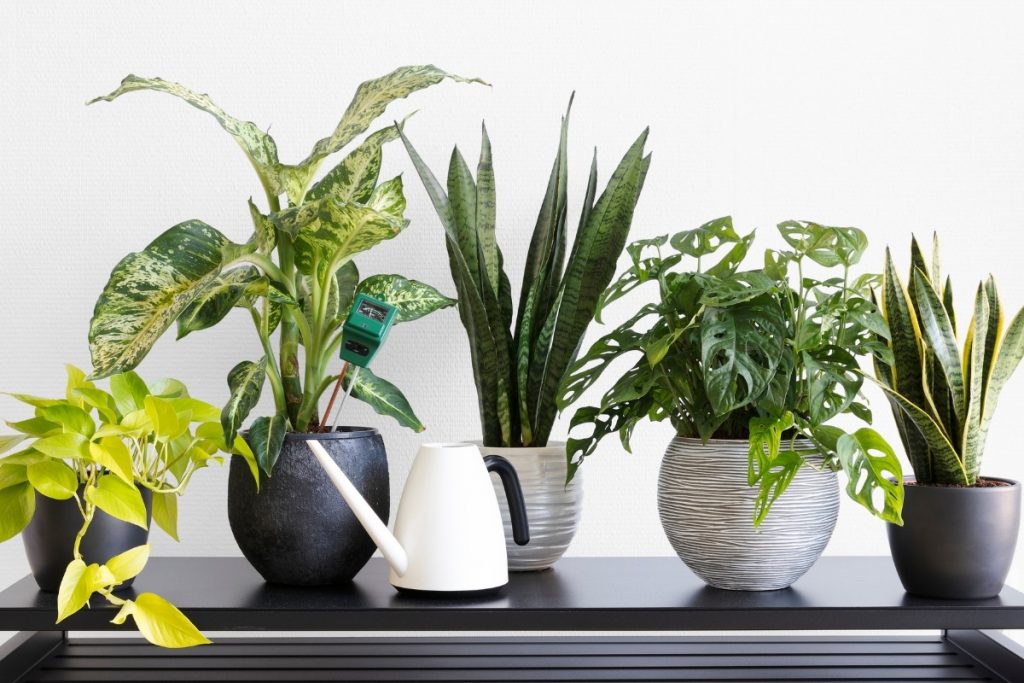Table of Contents
Introduction
Houseplants are a perfect addition to any home because they allow us the opportunity for year-round greenery. With colder winters and hotter summers, many people find themselves spending more time indoors than out; however, this is not necessary with house plants! They come in all shapes and sizes so there’s always an option when it comes down to choosing what best suits your needs as well aesthetically pleasing style preferences too
We often get the support of our human companions in words: I love you, get well soon, or thank you. Plants on the other hand speak to us with generosity as they donate their life whenever we come home; it’s not just about breathing air into us but giving new meaning and dimension through touch!
We all know that plants breathe CO2 and consume many other pollutants. They give us clean, new oxygen in return for their food which is why we need large forests! However there’s something you can do at home by growing a few valuable ones like palms or citrus fruits – this will help reduce the number of harmful gases released into our airways as well protect against global warming (and cooling).
The air you breathe in your home may be up to five times worse than outdoor conditions. This is because homes are often closed off from sunlight, which helps remove toxins and chemicals through natural processes like ventilation or photosynthesis; but when there’s no light coming into buildings it becomes difficult for these processes to happen efficiently- leading them instead onto a path where they’ll just create more problems down below (i e., indoor pollution).
Indoor air quality is 5 times worse than outdoor conditions. The build-up of toxic fumes and chemicals can cause all sorts of health problems for people who live in their homes, even if they keep them closed most hours during the day!
Indoor plants are the best medicine for your lungs! Every day, they provide you with fresh oxygen and take away all of those harmful particles in their wake. Not only do we need them outside because it’s too hot or cold where I live now ( Arizona), but if work inside an office building then there is no better way to keep comfortable than by using plant decorations that will help clean up any smells around here too!.
A few simple steps can make sure theirs don’t just look pretty; They act like living creatures providing us humans something necessary- Air Flow!!
There’s a certain satisfaction in knowing that you’re responsible for the growth of something. And when it comes to plants, there is no sweeter feeling than tender love and caregiving; which will only lead one down an endless path of joyous returns as they receive more smiles back from their plants due solely because people took time out (and energy)to give them what was needed: Tender Loves
Houseplants are living things that require a good amount of light, moderate temperatures, and water to survive. They also need the soil they’re in to be drained properly so air can move through its roots easily as well as nutrients from fertilizers or natural growth-boosters like fertilizer crystals which contain micronutrients such as magnesium for strong stems/leaves among other benefits.
If you want your plant to thrive and grow beautifully, the soil must be in perfect condition. When plants are grown properly with good care they will reward their owner by providing luxuriant growth like no other creature on earth could ever do! It might not happen right away; this takes time so patience must always remain key while growing these beautiful creatures- but eventually, we’ll need new pots or containers for our prized possessions because as any gardener knows “they don’t make houseplants out of bad dirt.”
Some plants require a little extra TLC than others, but they’re all worth the effort. You will probably need to clean their leaves somewhere down the line if you see that they are dusty or infected with diseases like rot – this is especially true for indoor-grown houseplants! You will have to keep an eye out for diseases, fungi, and pests (yes, plants can get sick too!). Make sure it’s done right at first so your plant rewards YOU by growing lushly into bloomers full of beauty ultimate victory over woes worldwide repotting time!
Houseplants are the best way to liven up any space, but they need special attention and care. In this article, we’ll cover what you should know before getting started with houseplant gardening!

Houseplants for Beginners: The Ultimate Guide
Houseplants can make your home a more welcoming place to be, with their vibrant colors and exciting life. Not only do plants produce fresh oxygen for us but they also extract carbon dioxide from the air which cleanses it as well! In addition, there have been studies proving how good house planting is not just decorative; they are also good for your wellbeing.
Indoor plants are great for decorating, but they can’t replace trees in your yard. For example, you might like the look of a pine tree or eucalyptus on your windowsill- however, if this is what you decide to bring inside instead – know that it won’t become just another houseplant! Plants need plenty of space (more than most homes offer), sunshine & water which may be difficult without access outdoors; plus food often needs additional care such as watering regularly–but don’t worry we have lots more tips below about how easy parenting indoor greens are!
Indoor plants are usually small and have attractive leaves. They also need a fair amount of attention, but this doesn’t mean you should constantly hover over them as sometimes too much can kill the plant! Here’s what else needs checking daily or weekly to keep your indoor garden happy.
Bring Life To Your Home With House Plants
Whether you’re looking to fill your home with vibrant flowers or lush greenery, there is an option for everyone! Some people can keep their houses feeling alive year-round thanks in large part to indoor plants. However, others have been struggling lately and continue daily just trying not only to keep the same few types of houseplants happy longer than they would be without human care–sometimes even getting lucky if it’s something like basil that doesn’t require much sunlight but will still die quickly without attention once its leaves dry up completely between watering session.No matter what your level of interest or expertise might be, it’s always helpful to have a general understanding of how to take care of the house
There’s no secret to keeping plants happy, healthy, and thriving. Do you need a green thumb or some kind of secret trick? Not at all. All you need are a few basic guidelines which we will go over in the coming chapters!
Before all else, though it’s important you think about where exactly this will be placing this plant? And then buy one well-suited for its location in terms of size/shape etc. Don’t be afraid to ask questions at a local garden center or even online since there are countless people out here with green thumbs willing to give support & guidance as we navigate world potted plants!

This article can provide guidelines and information on how to care for various plants, there are many different types of plants that can be grown indoors or outdoors. You should always research the best way for your specific type to grow so you know what conditions it requires to thrive!
Indoor plants are not just for those with green thumbs. You can learn to care for and enjoy the beauty of indoor plant life even if you don’t naturally have that gift! There is no better way to brighten up your living spaces than by filling them full-time with healthy, vibrant vegetation. These beautiful companions will breathe new life into any room they’re in; bringing color as well as fresh air into every corner within reach.
House Plants As Decorative Assets
Indoor plants give homes a livable, natural feel. With so many types of indoor greenery available today – from flowers and palms to shrubs or trees- you can create the perfect atmosphere for any room in your house! From greenery that naturally grows in areas near where you live and blooms all year round like flowers or evergreen trees (depending on the climate), plant vendors who offer exotic species from around the world such as palm hearts and tropicals – whatever type suits YOUR fancy!
There are endless possibilities for decorating with house plants. Simply add some green onto your fireplace mantel, coffee table, or piano; embellish an interior bay window by displaying flowers and leaves in pots on either side of it – filling up this space so that you can enjoy their fresh scent too! Not only will they help keep the air clean but also make it more aesthetically pleasing too! Some people like to place plants on furniture and if you’re one of them, we recommend using a waterproof placemat or saucer under the pot. The finish can get damaged from seeping moisture in some cases so it’s best not to leave these pots without protection!
You can find containers around the house to use for pots. Salad green is a good choice, as it makes an excellent greenhouse where you would like your plants to grow more easily and quickly than in soil-based setups (like my mom’s kitchen). Buckets/bowls are another option if space isn’t too much of a concern; just make sure they have holes bored into their bottoms before adding anything else so that excess water doesn’t damage nearby furnishings! Another alternative might be plastic cups or even old paint drums–whatever works best suits what situation I guess it is what you should go for!
The best way to give your plant some sun is by placing it near a window. Not only do plants love the floor space, but they also enjoy hanging and climbing on things that are provided for them! You can buy macrame hangers from any store or find chain links with hooks at most hardware stores; these will work well in helping you hang up this awesome decoration in your home easily enough without taking away too much attention from other items around here too!
Choosing A House Plant
When selecting indoor plants, make sure they are adaptable but also reasonably hardy; I would advise buying from reputable garden centers or even at the supermarket! Box stores typically have houseplants available for good prices too – perfect if you’re on budget constraints like myself (I’m always looking out for sale items).
Light. What kind of light does your home have? If it’s dark or you live somewhere with limited sunlight, grow lights can be bought to replace natural sunbeams. Not a perfect solution but they do work well in homes where there isn’t enough strong window exposure for plants that need direct sun like most indoor plant species do (especially ones requiring warm climates). Instead, consider filtered indirect rays which provide just enough warmth without causing too much harm!
Size. What is your budget? You can buy a Boston fern for around $1 in an inch-sized pot. It will have three leaves and probably look pretty frail – but it’ll grow! If you want something more elaborate, like the size of a beach ball or even bigger…it just depends on what exactly are looking to spend/how much room you have to work with.
Living Space. Give your plants the best chance by considering their space limitations. Palms are beautiful, but how high up do you have ceilings? These beautiful trees have wide leaves and their height can range from ten feet high on the outside (if they’re grown indoors) up to nearly fifty-inch trunks! The space limitations are dependent upon how big of an area there is inside; however- be mindful about where ceilings are because this type doesn’t grow horizontally so make sure any spots near these areas aren’t too cramped before choosing whether or not one would work well within those parameters.
Caring For You Houseplants
Indoor plants are a great way to bring life and beauty into your home. They require minimal maintenance, which makes them perfect for those who have busy lifestyles or just don’t want the hassle of taking care of an animal as well! No need to take them out for a walk or worry about leaving them alone. If you buy a timed light, you will come home to a private oasis. This is why I recently bought some indoor house plants that need minimal attention.
At first, you may be very nervous about buying indoor house plants. If you’re looking for beginners’ plant options try getting advice from those working at local nurseries – they’ll help select hardy types that need little maintenance The world of gardening is filled with endless possibilities!
If you want to start your garden, but don’t know where or what plants would be best suited for beginners like yourself. Consider getting an African violet! It doesn’t need much attention and the flowers are beautiful. Most of this type of flower only needs enough sunlight to grow healthy, colorful petals that bloom in all sorts of colors- pink/white or purple depending on the variety -from reds through shades between yellow och green. That’s all! No special attention is required to enjoy the colorful flowers.
The Christmas Cactus is another plant that can grow easily in the home. This trailing succulent generates gorgeous pink or red blooms, typically during wintertime! More importantly, though- it needs low light and little water to thrive; making this an ideal option for people who are usually out all day but still want their space decorated with beautiful flowers when they come back at night (or early morning).
If you’re looking for a plant that doesn’t need much water and light, then the Snake Plant may be perfect. Since they are extremely hardy, they are a common option for offices, waiting rooms, building lobbies, and other public places. These are very popular plants because they last so long without getting damaged or killed by neglect! Plus their roots don’t grow any deeper than four inches which means it is almost impossible for them to die from over-watering!
Light
The most basic necessity for plants is light. Without it, they cannot survive and grow into what we know as ‘ vegetation.’ The light consumed by these organisms allows them to transform their energy into sugars or starches which are necessary to reach survival goals such as fulfilling nutritional needs (glucose), storing carbon dioxide through photosynthesis, etc. Insufficient light essentially starves plants. In short: insufficient shady environments will kill your plant!
We can’t take our eyes off of the plants! The more we pay attention, the better insights they provide about what might be going on with their lighting needs. For example, if a plant becomes pale or spindly it’s telling you that there are not enough lights around for this strain and species (or even individual). Another indication is when flowers don’t form at all despite ample amounts of natural sunlight being available; weak blossom size coupled with thin leaves could also mean insufficient illumination.
You can’t be too careful when it comes to your plant’s lighting needs. Make sure you check the specifications on their package and if in doubt, look up online!
The amount of light your plant requires depends on its species and leaves. Generally, plants with lighter foliage need more than those that have darker shades because they don’t produce as much chlorophyll which helps them photosynthesize better in low-light conditions; however, there are some exceptions to this rule such as indica varieties whose chief purpose is Genius (growing) rather than Beginner(fertilizing).
Humidity Control For House Plants
We all know how important water is to our health and well-being, but did you also realize that it’s essential for plants as well? Plants cannot grow or stand erect without a minimum amount of moisture. When the air gets into the cells of an herbaceous plant (like grass), they expand with ease because there is no tension holding them down like when soil particles become compacted together due to either lack of rainwater intake or too much sun exposure; this causes stalks/leaves on these types species rise upwards towards their optimal level before gravity takes over again thanks so now supporting weight rather than bending under its own accord!
House plants are mostly tropical and prefer humid air. They need to breathe for their organs and tissues to function properly, which means that they want humid air around them too! Dryness causes a plant’s surface moisture to evaporate, which can leave it vulnerable in dry conditions – but if you provide your houseplant with enough water as well as good circulatory action around its roots (and therefore throughout), this will help keep them healthy!
The best way to keep your plant healthy is by providing it with enough water and humidity. Plants with thinner leaves are more vulnerable to air moisture deficiency. In other words, the more humidity, the better. However, humidity is also a breeding ground for fungus and mold, so don’t overdo it! Fungi can cause problems such as nutrient deficiency which makes plants susceptible to bugs like aphids who love eating away at soft tissue until their fatal toxins start swelling up around their body parts destroying them from within.
What’s the best way to know if your plant is going well? It might be worth checking its environment first. The USDA Plant Hardiness Scale rates areas from 1a – 13b, with 1 representing very cold temperatures and13 suffocating heat; there are also A-H for humidity levels in general climates (Köppen classification). So when looking at which plants would suit you most accurately predict their zone preferences too!
If you are nervous or unsure about the humidity level in your home, purchase a hygrometer! It’ll let know whether or not there are high levels of humidity around, so make adjustments as necessary based on what plants need most (and remember – they’re usually more sensitive than humans). You could also get an online thermometer that displays data from both indoors and outdoors.
Air Circulation
Just like humans, house plants need fresh air to breathe. Make sure you provide your plant with a good circulation of air by opening a window now and then or using a fan to circulate the air around it. This will help keep your plant healthy and prevent any problems caused by too much humidity or dryness.
If you’re using plant lights (which produce heat), try finding another place for your plants. Otherwise, put a small fan in the room that gets the air moving near and around them; don’t point it directly at their roots or they’ll dry out quickly! There are fans available market too – passive ones which keep circulating gentle breezes without constantly beating down hard all over everything else nearby…
Window with natural light and good circulation, this is an excellent place to put your plants. The temperature changes created near a window naturally produce some air movement, which is often enough for plants.
For a more accurate reading of how well your plants are getting enough oxygen and movement, test it with a candle. Light a candle and put it in the area. If the candle flickers, there’s enough circulation of fresh air for your plants!
Temperature Control
Most of our houseplants come from tropical climates, We all know that plants like what we like, and most houseplants come from tropical climates. That’s why it is so important to take care of them by providing for their needs in temperature! which typically range between 65 and 75 degrees F (18-24 degrees C) at daily temperatures. But don’t just assume this is fine and move on. There could still be problems, such as an issue with air circulation we discussed earlier in the article!
Moving a plant from one environment to another can be stressful for the roots. For instance, if you bring your geraniums into cool areas such as on front porches during winter and they experience sudden temperature changes that are too warm or cold – this could shock their system resulting in damage! The best time to move them is when there’s been an even shift between both outdoor/indoor temperatures throughout the autumn months so it doesn’t cause any problems with rearing young plants inside again next year (or ever). The best time to move the plant is when the outside temperature and indoor temperature are relatively similar.
Wilting or drooping leaves are an indication that plants have been shocked by a sudden change in temperature. This can be caused by either cold weather, too much humidity (a common problem with houseplants), or because they’re not getting enough light at night when you don’t want them opening up their pores for air circulation again – these types of attacks will make your plant look bad overall even if there isn’t any visible damage on its exterior! Wilting occurs when moisture evaporates away from wetted surfaces; this process is accelerated due to high levels of radium-rhenium oxide found within the soil which acts like sunlight until Photosynthesis steps into play using carbon dioxide.
When plants are exposed to long periods without air conditioning or heating, they can experience shock. This will lead the leaves of your plant to turn yellow and eventually fall off – it’s not something you want happening! To avoid this from happening: make sure there is always adequate humidity in surrounding areas.
Cleaning Your Plants
One of the most important things you can do for your plants is to keep them clean. Cleaning will not only prevent dirt accumulation but also help with leaf infection and watering efficiency! This can be easily avoided by taking a few steps to keep your plants clean and free of debris.
First of all, cut and remove any dead brown or yellow leaves from the plant. In addition to this, you must check for dried-up flowers as well because they can accumulate diseases which will harm your alive plants! remember regular maintenance helps prevent problems before they start.
Secondly, wipe down the leaves of your plant with a damp cloth to get rid of any dirt or dust that has built upon them. If you have especially large leaves, you can use a soft brush to avoid damaging them. Clean your houseplant – the easy way. First, use a moist cloth or soft-bristled toothbrush on larger leaves from the bottom-up while being careful not to crush them but simply support with hands if needed for smaller ones. You can also give your plants a brief ”shower” once in a while (yes, in your bathroom shower!).
Give your plants the royal treatment by giving them a gentle bath in the sink. When giving plants a “bath” in the shower, gently spray the leaves using a nozzle with low water pressure. Place smaller, delicate-looking types of vegetation into containers filled halfway so that they are propped upright while being cleaned—this will help avoid crown rot complications caused due having excess humidity near its roots.
Tips
- Use only room temperature water to clean. Cold water will leave spots on the foliage and hot water can damage your plant.
- Be careful of soil loss when rinsing your plants. You may want to cover the bottom of the pot with a plastic barrier to avoid this.
- Do not use any products designed to improve leaf shine. These products tend to block the plant’s pores and prevent proper respiration and photosynthesis.
One old tip is to clean glossy leaves with milk, but caution should be taken not to use too much to ensure that the plant’s follicles are not obstructed.
Watering
There are a few important things to know about watering your plants. Under- and overdoing it can cause damage. Growing indoor plants can be challenging, but it’s easy to give them too much or not enough water. It may seem like a small detail that could never harm your plant—and in most cases this is true! But under- and overwatering both have negative effects on the health of a beginning as well as future growths, so learn how you should care for all those pretty leaves with these helpful guidelines from our experts:
The best way to determine whether your plant needs water at any given time is by feeling the soil with a finger. As a general rule, plants with very thin or very large leaves need more frequent watering. It’s usually recommended that you check about 1/3 of the depth for moisture in order not to over-shield or underfeed them and kill off their roots.
What’s better than rainwater for your plants? Drinking it! Simply place a bucket outside before any rainfall and collect the cups that fall into this vessel. Then, pour these precious fluids onto hungry houseplants to keep them happy (and maybe even give them an extra boost in their health).
When watering your plants, be sure to pour the water onto its surface slowly until it starts draining from below. Remember that two-thirds of a pot’s volume is occupied by roots so you will want this saturation level enough for normal growth and development without allowing any excess salt or fertilizer residue on top which could cause problems later downrange if not washed away quickly after each session with tap runoff (a major source). After thorough soaking followed by an ample drying period as described above–most plants only require weekly sessions at most!–you may repeat everyday maintenance tasks like fertilizing etc., depending upon what type/size your leafy friend is.
If you see that the soil pulls away from the sides of the pot during watering, this is a sign that you allowed the plant to dry out too much between the watering. It can also mean that the soil is compacted, which can be remedied by using a chopstick or other stick to poke holes in the soil (just be careful of roots!).
One way to water your plants is by placing them in a saucer and allowing the roots to soak up all of that moisture from below. This will allow you only so much while preserving nutrients at home – just make sure not to overdo it!
Watering ideas to keep in mind:
- As plants grow vigorously, they need water – especially when the sun is bright and the temperature is high.
- Small water pots (especially terracotta and clay pots) dry out several times daily during the growing season. Plastic pots keep water longer.
- For most plants, you should avoid leaving the watering until the leaves start to droop. In general, this is a sign that the plant has already gone too long without water, and it will be difficult to re-hydrate it fully. However, other plants such as fittonias and peace lilies do quite well if they are only watered just after their leaves start to droop. They are “drama queens” whose leaves are far more sensitive to a loss of moisture, and you can essentially use their leaves as an indicator as to when to water. When you get a new plant, look up whether or not this is a safe practice for that species.
- Choose a moist potting mix. Learn to judge between well-moistened and waterlogged. There should still be some air in between the soil particles of a properly moist mix, so when you press down on it with your finger, there should be some elasticity and “bounce”, whereas a waterlogged mix will simply feel like putting your finger in mud.
- Water plants completely to cover all areas of the pot. Do not add too much water, or useful nutrients will be washed away. If water drains out of the bottom of the pot, make sure the pot is not left in a pool of water, as it will cause the roots to rot.
- Some plants should be watered from below, such as African Violet or other fuzzy-leafed plants. Stand the pot in water at the same level as the potting mixture and soak until the water starts wetting the surface.
- In general, be careful of over-watering. Over-watering is just as common a mistake among plant owners as under-watering is, and over-watering can be far more dangerous as it can cause root rot that is difficult or impossible to remove entirely. During the dormant season, only water your plant once or twice a month.
- Tap water is generally OK, but minerals in the water might affect some plants negatively. If you live in a region that has hard water, use filtered water to ensure optimum growth.
- Automatic watering systems are available for when your plants will remain unattended for a while, but grouping plants together also helps to maintain moisture.
- Don’t let peat-heavy potting mixes dry up completely, as they can be difficult to re-moisten.
Type Of Houseplants
The variety of house plants is vast, with options for every taste and preference. You can find just what you’re looking for by organized into different categories like size or water needs!
The following are some of the best plants for beginners. They’re all easy to take care of, but they’ll provide you with vibrant beauty and give your home that green thumb!
Beginner/Easy Plant Varieties
Snake Plant

Sansevieria (Sansevieria trifasciata) – Also known as the snake plant or “mother-in-law’s tongue”, this is one of the easiest plants to take care of. It requires very little water or light. Ensure that it is potted in very well-draining soil and that its leaves are regularly wiped clean of dust. It has recently been renamed Dracaena trifasciata.
ZZ Plant

ZZ Plant (Zamioculcus zamifolia) – This plant, which has dark waxy leaves and a thick, upright stem, is extremely drought tolerant, only needing to be watered once or twice a month. Like the snake plant, this is a popular choice for office buildings and public spaces due to its low maintenance needs.
Pothos
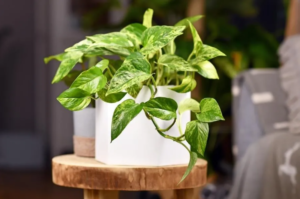
Pothos – Pothos is a broad-leafed plant that grows very rapidly and is tolerant of low watering. The most popular variety is the Golden Pothos (Epipremnum aureum), which has beautiful yellow marbling on its bright green leaves. These tropical plants will tolerate some time between waterings—you can even wait until the leaves start to droop a little before watering (just don’t leave it too long!)
Succulents
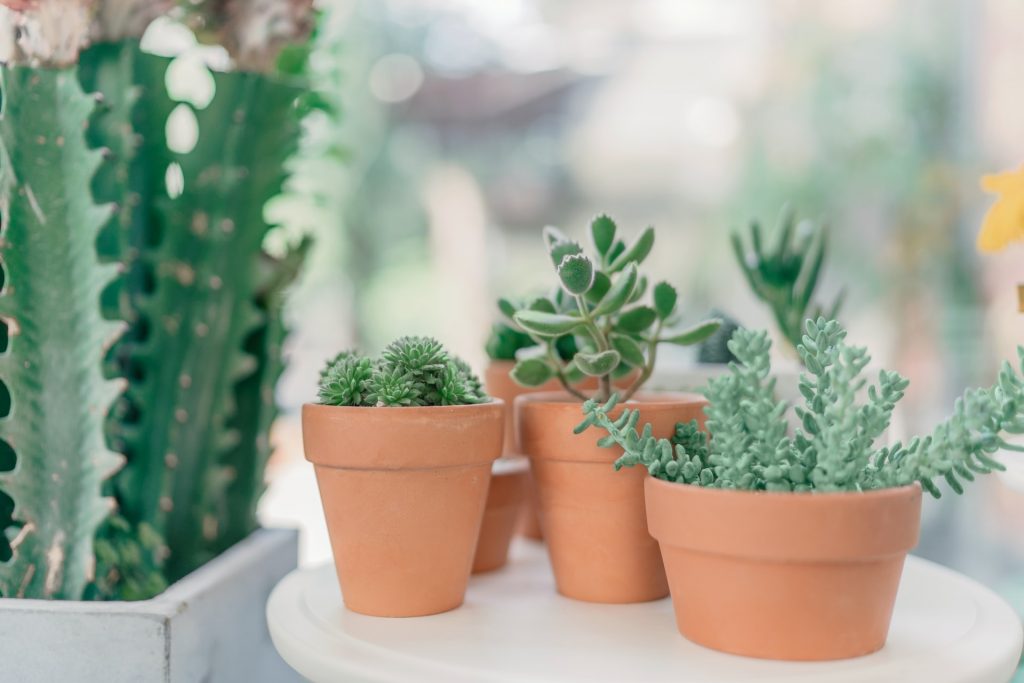
Succulents – A succulent describes any plant that has thickened stems or leaves and retains water in dry environments. This is not one particular species or genus, but rather a generalized category of plants based on several characteristics. They are, however, very popular and easy to take care of thanks to their high drought tolerance. They usually require bright light and well-draining soil, but otherwise need very little attention to thrive and can even produce beautiful flowers under the right conditions. Some examples of succulents are aloe vera, echeveria, and cacti.
Spider Plant
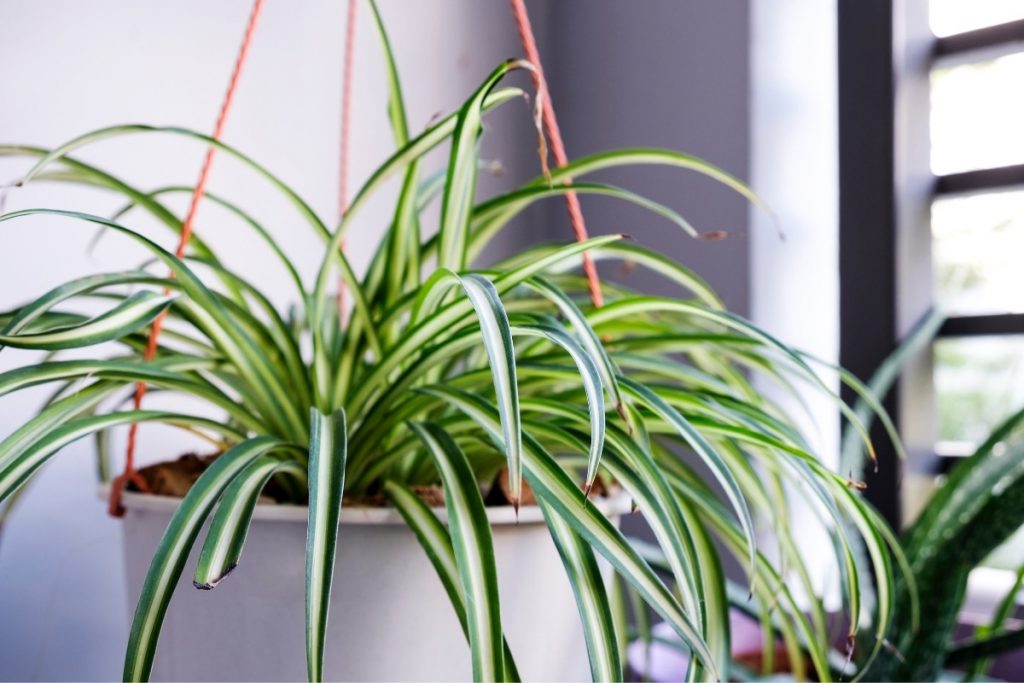
Spider Plant (Clorophytum comosum) – These plants are very hardy and can adapt to almost any environment if they are given time to adjust to it. Some plant lovers believe this plant is happy when its soil is allowed to dry out a bit, but my experience is to not let it get too dry. If the tips of the leaves are brown, it is long overdue for watering. It also produces “pups” (new baby plants) at the end of its long, thin leaves, which you can pick off and replant once they are ready. There are also some newer varieties with curly leaves.
Wandering Jewel

Wandering Jewel (Tradescantia zebrina) – Also known as the “inch plant” or more recently “wandering dude”, this plant grows extremely quickly and is very easy to propagate. It comes in a variety of colors, ranging from light green to dark purple, and is very difficult to kill. It does require more humidity and attention to thrive, flower, and look its best, but it will continue to grow even if conditions are not ideal.
Philodendron
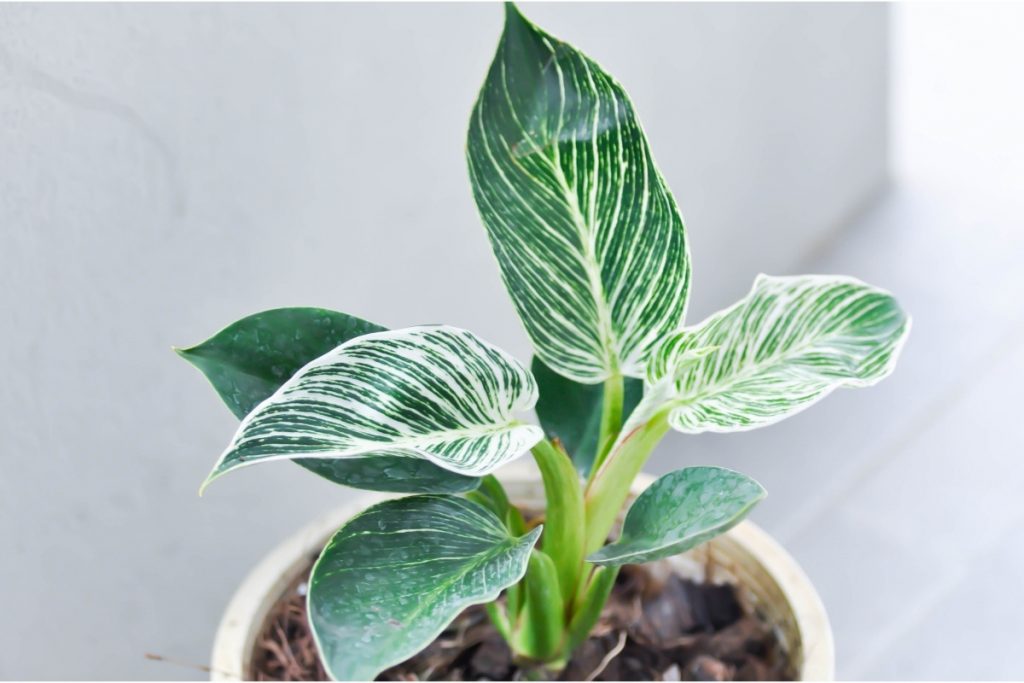
Philodendron – similar to pothos, this is a trailing plant that grows quickly and is relatively tolerant of low light and infrequent watering. The most common variety is the Heart Leaf Philodendron, which, as the name suggests, displays bright green heart-shaped leaves.
English Ivy

English Ivy (Hedera helix) – another trailing plant, the English Ivy requires very little water and looks great in a hanging planter. Undoubtedly you are familiar with what this iconic foliage looks like, but maybe you didn’t know how easy it is to introduce it into your home. Ivy appreciates some humidity and is susceptible to spider mites if the air is too dry.
Rubber Plant
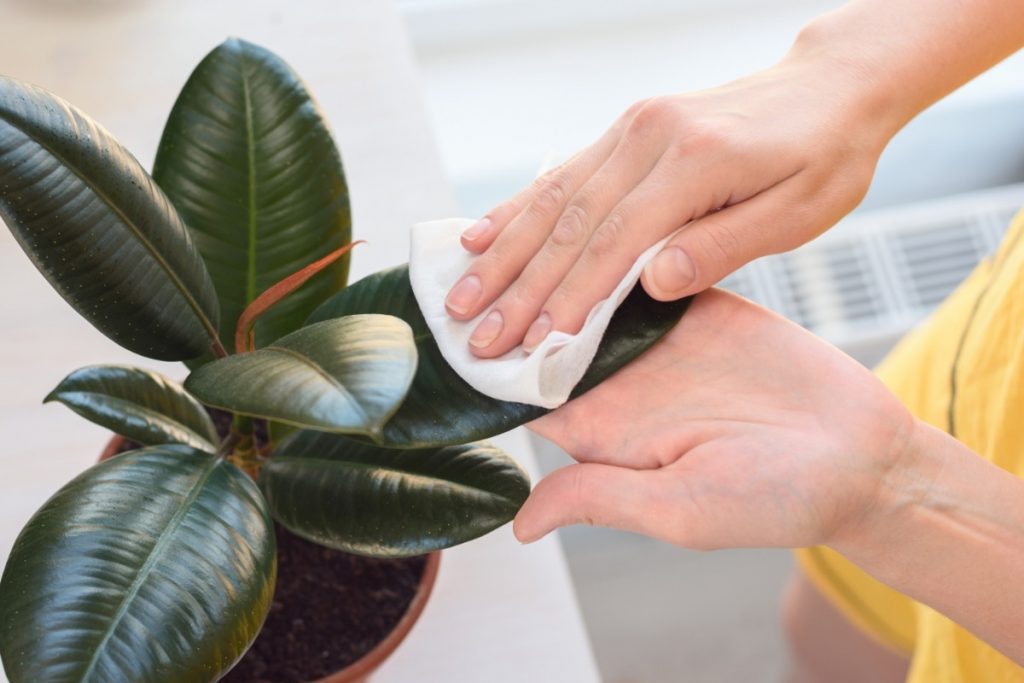
Rubber Plant (Ficus Elastica) – This species of ficus is popular for its thick, glossy leaves. It can grow to be a few feet tall and does well with high humidity and regular dusting. It also comes in some interesting colors- for example, the “Ruby” variety has a beautiful marbling of pink, red, and dark green across its shiny leaves. It is a fairly easy plant to grow.
Begonia
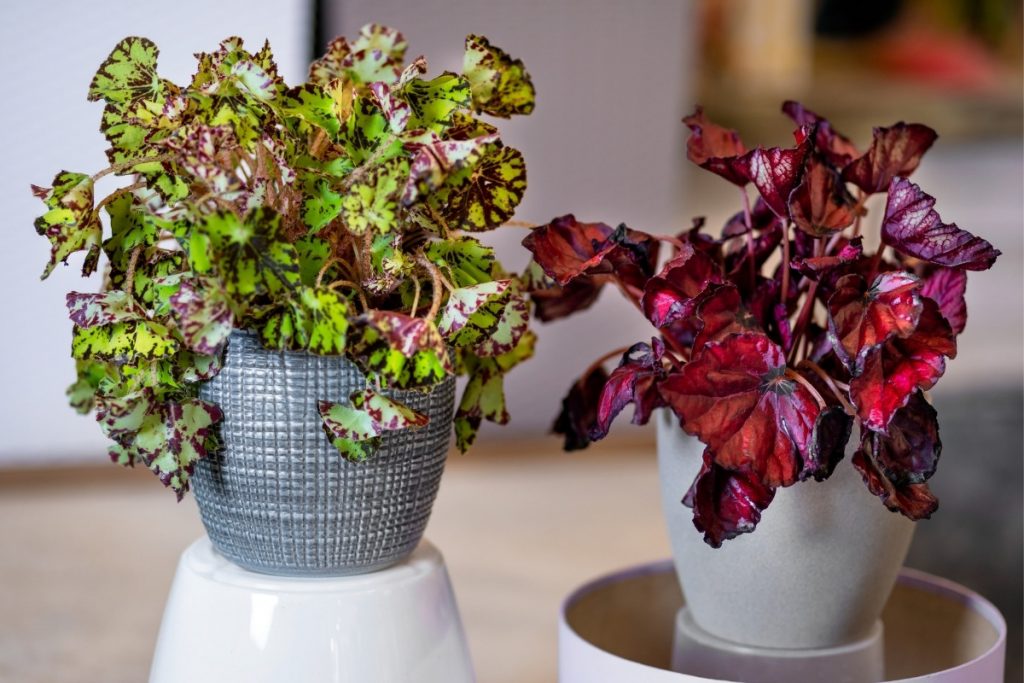
Begonia – Easy to grow and propagate. Ranging in colors from green to red to brownish foliage and often colorful pink, red, yellow, or orange flowers. Most varieties love a little bit of shade, perfect for a houseplant. Rex begonia is a popular variety that needs a bright window and a fair bit of light. They have fibrous fleshy stems and waxy leaves often with designs.
Christmas Cactus
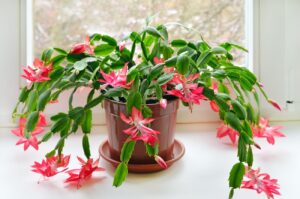
Christmas Cactus (Schlumbergera) – this succulent/cactus variety is named for its flowers, which are usually a bright red, pink, or orange and flower between Thanksgiving and Christmas in northern hemisphere locations. They are made up of trailing, segmented leaves which are very easily propagated. Unlike most cactus varieties, however, this is a tropical plant (native to Brazil) and will do best with regular watering, humidity, and indirect sunlight (or partial direct sunlight in the winter months).
Aloe Vera
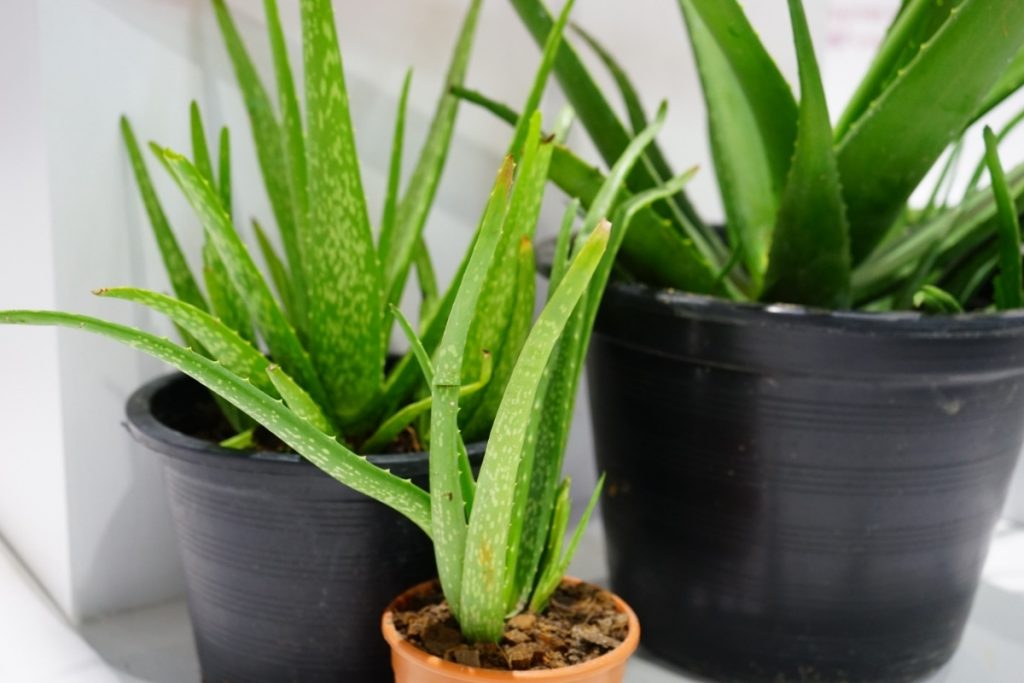
Aloe Vera (Aloe barbadensis miller) – another variety of succulent, aloe vera and other aloe varieties are popular because they are easy to care for and can provide medicinal qualities. You may have put aloe-based lotion on after a long day at the beach, but did you know that you can simply cut open an aloe leaf and spread it directly on your skin to achieve similar benefits? These plants do best in well-draining soil and bright, indirect sunlight.
Jade plant

Jade plant (Crassula ovata) – also known as “lucky plants”, this popular succulent grows as a small tree, with woody stems and thick, water-retaining leaves. They are extremely hardy, particularly with drought, so you can go long periods without watering or tending to them and they will still do just fine. They grow best with bright, indirect sunlight, well-draining soil, and infrequent watering. Jade is also easily propagated by taking off a leaf, allowing it to “callus” for a few days, and putting it in soil.
African Violet
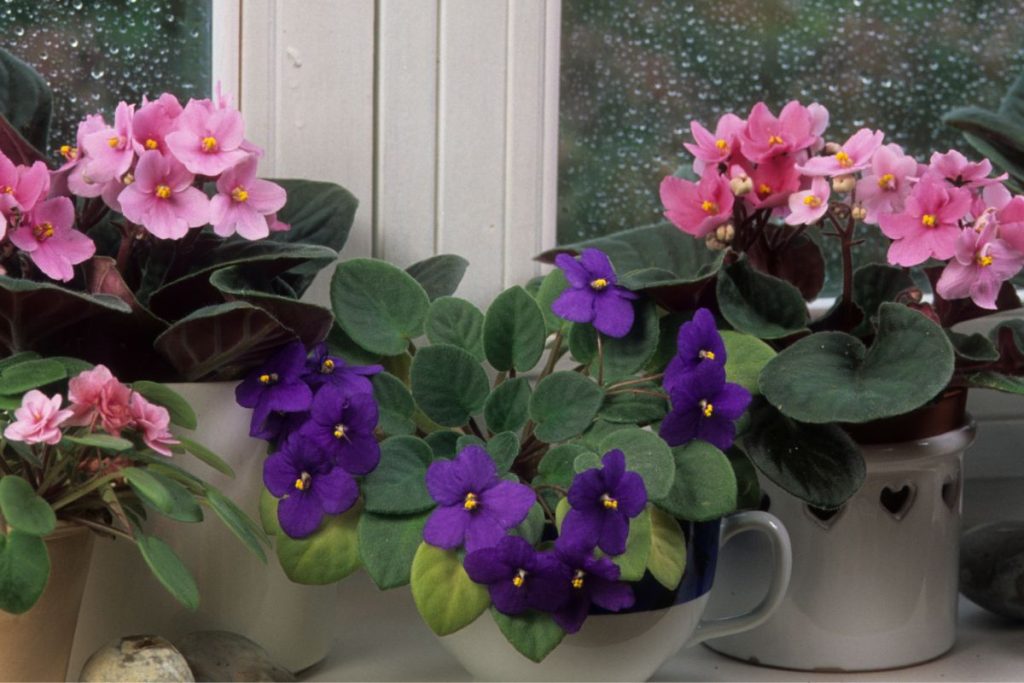
African Violet (Saintpaulia) – the African violet is a popular choice of houseplant as it is one of the few that flowers easily without heavy care or plenty of direct sunlight. It does okay in lower light, but bright indirect light is preferable. They do best when watered from the bottom and allowed to soak up the water, but they can be susceptible to problems when exposed to high humidity. Keep them in well-draining soil and a warm area with medium to bright indirect sunlight.
Medium/Difficult Plants
Peperomia
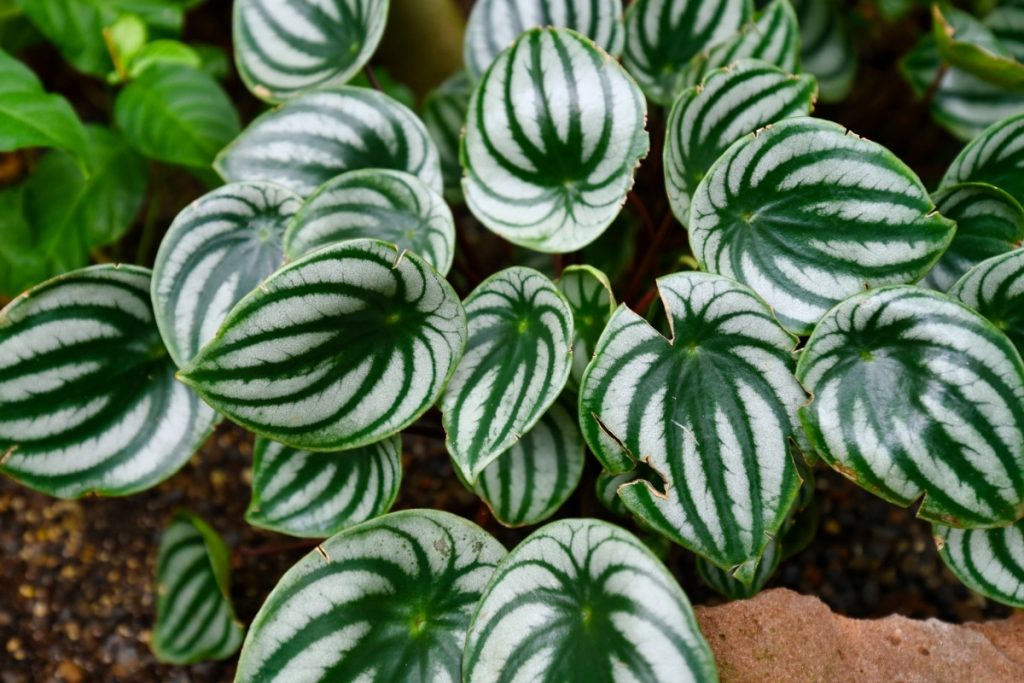
Peperomia – This is a large genus of plants, so there are many different varieties to choose from, but all of them have relatively low water needs. The foliage on these plants is beautiful, varying in texture and color from dark purplish-red to a light variegated green. These are usually pretty small, around 6-12 inches in height.
Prayer Plant

Prayer Plant – plants of the genera Maranta and Calathea are very popular for their low light tolerance and beautiful foliage, which usually has red or pink striations and purple undersides. They are called “prayer plants” because their leaves fold up like praying hands at night.
Peace Lily
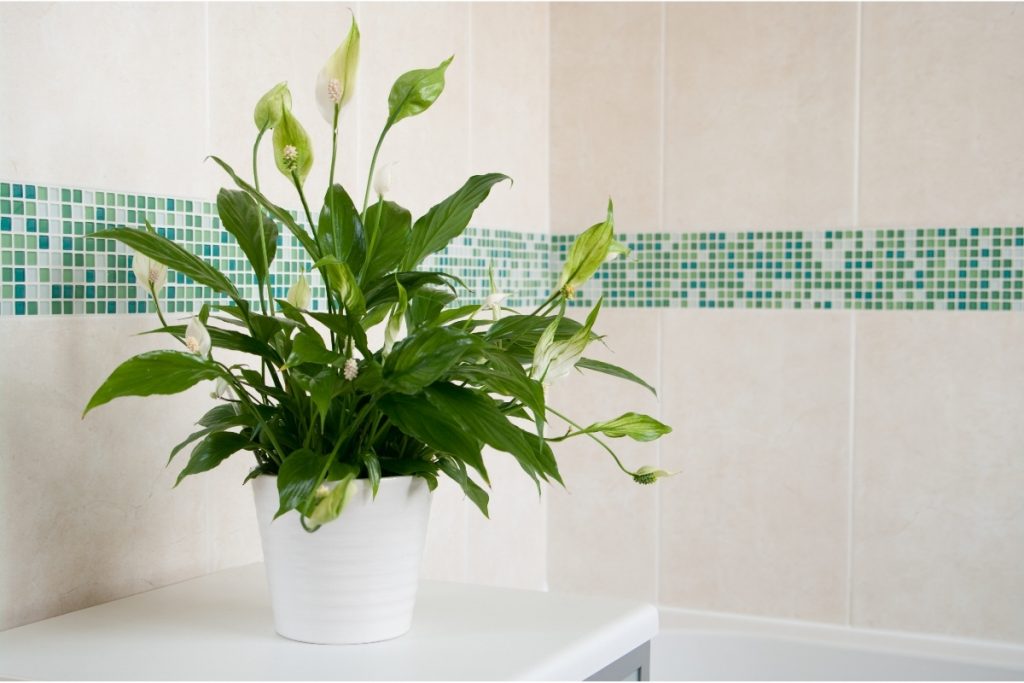
Peace Lily (Spathiphyllum wallisii) – This plant is known for its beautiful white flowers, its air-purifying qualities, and its tolerance to low-light environments. Like Pothos, its leaves will start to droop slightly when it needs water, so it doesn’t require any guesswork when it comes to watering, though it does best when the soil is kept consistently moist. This is another common plant in offices and homes.
Dracaena
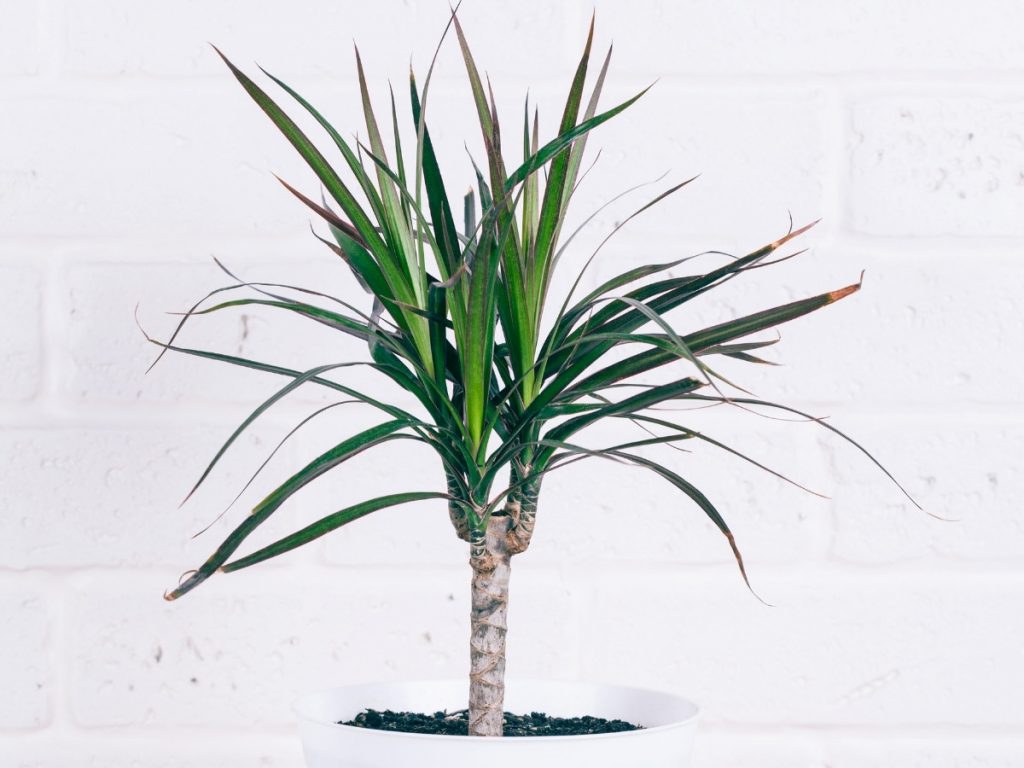
Dracaena (Dracaena marginata) – Also known as a “Dragon Tree”, this unique plant has thin, red-edged leaves and is very hardy and tolerant of neglect. They can grow up to 6 feet tall, so make sure that you have enough space in your home before committing to a dragon tree. Additionally, they are toxic to dogs and cats, so these plants are best for individuals who don’t have pets. The species “Janet Craig” tolerates low light and drought and needs to be watered only every three weeks.
Orchids
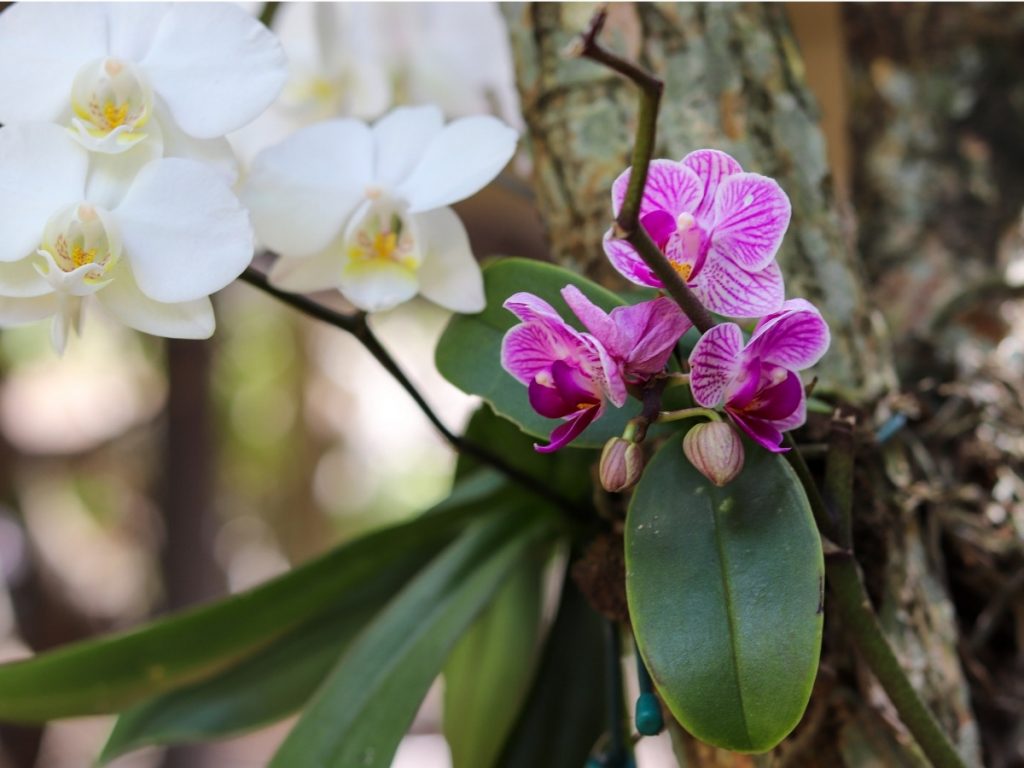
Orchids – These are popular in homes due to their beautiful, long-lasting flowers. Orchids are usually sold after they have set buds and are ready to bloom, and after this point, the flowers will last months with very little care or attention. It takes a bit of effort and commitment to get them to bloom again, but if you care to take on a challenge, these flowers can be extremely rewarding.
Bird of Paradise
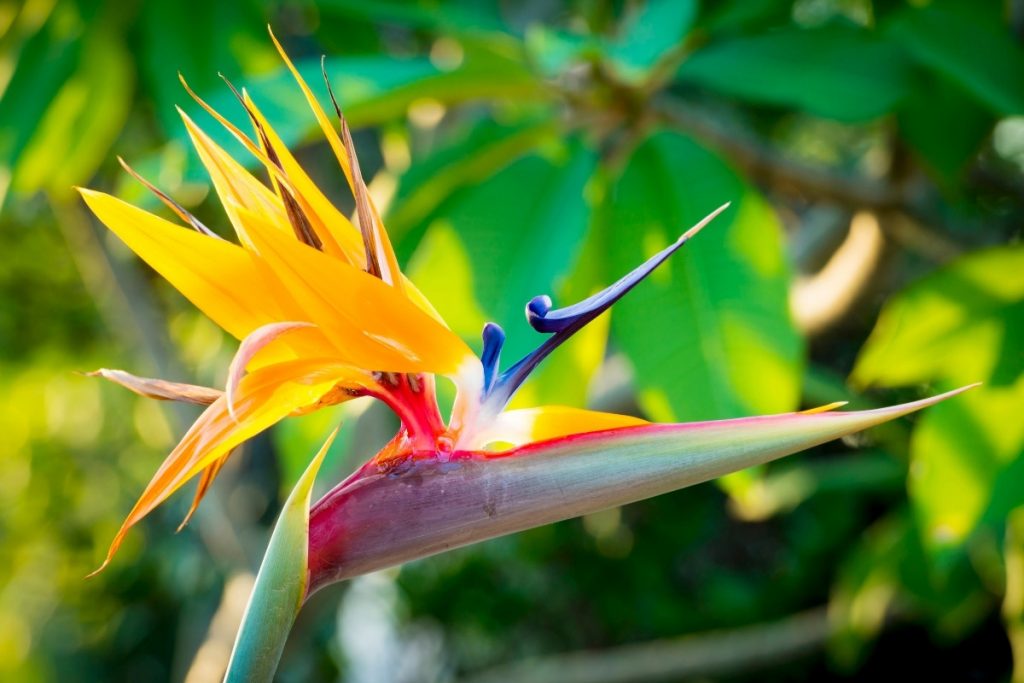
Bird of Paradise (Strelitzia reginae) – Cultivated for its large foliage and fantastic yellow and reddish blooms reminiscent of birds in flight, these plants can grow to enormous sizes and are great for filling up empty corners and making your house feel like a jungle. These tropical plants thrive well indoors with plenty of warmth and light, but can also be placed outside if you live in a warmer climate.
Ferns

Ferns – there are many varieties of ferns available, the most popular being the Boston fern and the maidenhair fern. They require more humidity and moisture than some other beginner plants, but with regular misting, they can be easy to take care of and will fill out a space with their densely-packed leaves. They also like indirect light.
Monstera
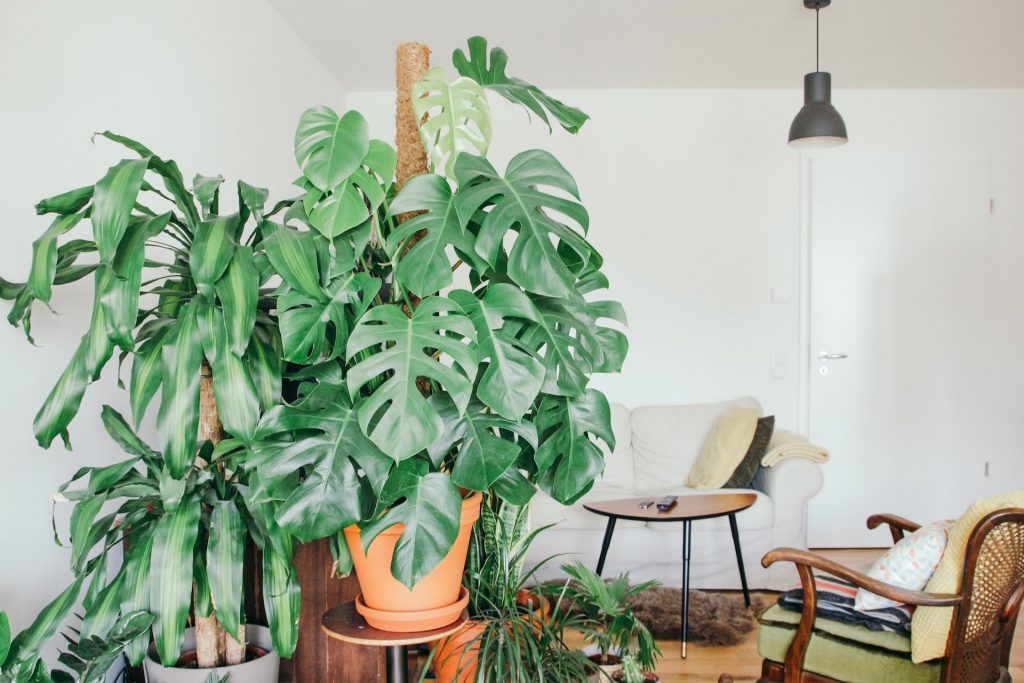
Monstera (Monstera deliciosa) – recently very fashionable due to its unique foliage, this plant is often mistakenly labeled “Split Leaf Philodendron”, though it is not a type of philodendron. The leaves can grow to be enormous, ranging from the size of your palm to bigger than your head. This plant does best with moist soil and medium to bright indirect light but is not particularly difficult to take care of and will fill your home with a vibrant and on-trend look.
Kalanchoe
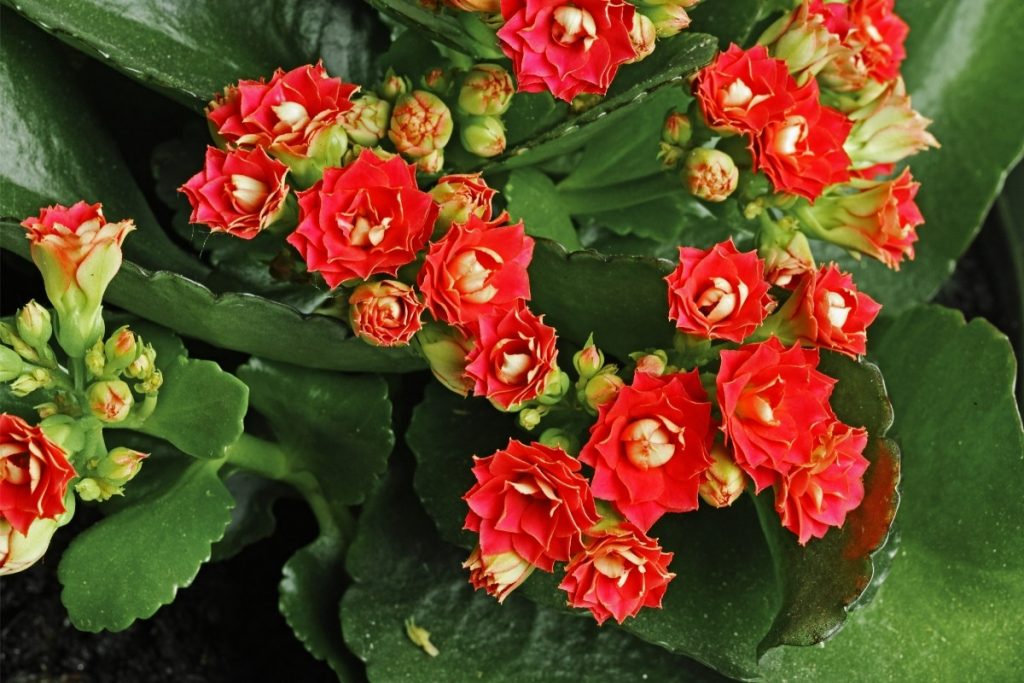
Kalanchoe (Kalanchoe blossfeldiana) – this plant is great for beginner plant parents who want a flowering plant without all the fuss. It comes in many colors including red, orange, yellow, green, white, pink, lilac, and salmon. The spray of tiny flowers is a great addition to any home.
String of Pearls

String of Pearls (Senecio rowleyanus) is a type of succulent but is a bit tricky to grow. It requires a lot of light but not hot burning light. They like a dry atmosphere and a little bit of fertilizer. Do not overwater or plant in a pot that is too big. It is stunning to look at and resembles peas on a string.
Weeping Fig

Weeping Fig (Ficus Benjamina) – These plants, which are popularly used as bonsais, can grow up to 6 feet tall with proper care. These trees stress easily but also recover quickly, so even if you are not perfectly on top of your care, it will bounce back. They are somewhat sensitive to light conditions and pests and will do best in a warm, humid environment with just a little bit of direct sunlight in the morning. Weeping fig will tell you when it’s dry when a first yellow leaf appears, and if a green leaf falls off, it is too wet.
Fiddle leaf Fig
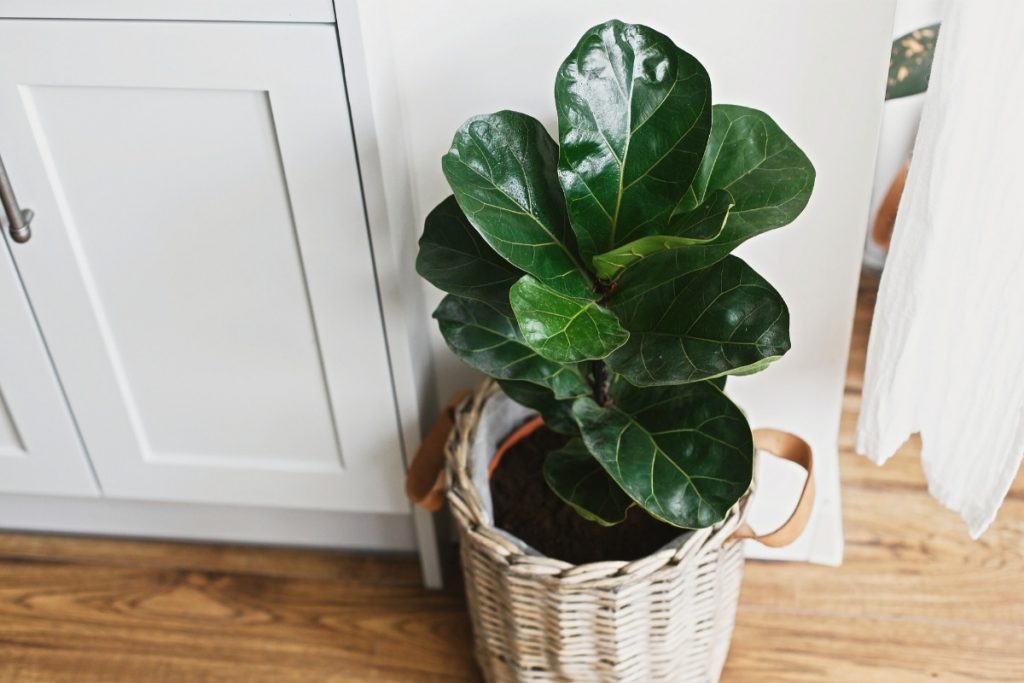
Fiddle leaf Fig (Ficus lyrata) – Originally from Africa, Fiddle Leaf Figs don’t mind drying out a bit between waterings. They then like a good watering. They like warmth and humidity and a fairly bright window. They can grow 6ft tall or even taller. Very popular in recent years, this is a great addition to your plant collection.
When you’re looking for a plant to add some life and beauty to your home, it can be hard picking out just the right one. There are so many different species of plants that exist! But don’t fret because we’ve got this list that will help guide you in choosing an awesome new addition whether they are small or large scale additions.
How To Choose Flowering Indoor House Plants
You can find a wide range of indoor plants at your local nursery or home supply store. If you have the time and means, it is best to go with one that specializes in flowers like this! we know how important coloration and longevity are when picking out an attractive arrangement for indoors. the following tips will help you to choose plants with the best color and longevity.
- Choose a plant whose flowers have not yet flourished, or are in the budding form. This will ensure that you get to enjoy the bloom for the longest amount of time.
- Consider the weather and the season before purchasing. You must be confident that if you carry them home, you will be able to support their temperature needs. Temperature and humidity can affect your plant dramatically.
- You should have an idea of where the plant will be placed in advance. It could be in your home, in your workplace, or anywhere else where adequate lighting and watering can be maintained.
- Flowers usually require extra fertilization, especially with a mixture that contains a high phosphorus content. Be sure to buy some appropriate fertilizer as well when you purchase your new plant.
When you visit the garden center, there are hundreds of plants to choose from. There are many things to consider, even beyond these four considerations, You’ll have an easier time finding what’s right for your space and lifestyle if you do some research or consult one of those specialists at the store before making any final decisions.
Flowering plants can be an excellent addition to an indoor space. Don’t let intimidation get in your way- indoor flowers may not be as low-maintenance as a succulent or a ZZ plant, but they can be equally as rewarding.
Air Purifying Plants
Housing is the world’s largest challenge as our population continues to grow exponentially. Houses are constructed everywhere, and many countries lack fresh air due in part to houses being put up without consideration for nature; though there have been efforts made towards sustainable building practices it can’t always solve all problems-especially when you consider how many spaces needed exist already!
The best way to get rid of pollution in our environment is by breathing fresh air ourselves. If you don’t live near enough parks or have any outside space at all, consider making your own “small” park inside! The plants will filter out contaminants around them while filtering oxygen into their surroundings which means they help make everything better for everyone living there – even if just one person has them as a part-time planter (and let’s face it who could say no?).
Plants are the ultimate cleaning staff for human hosts. They use up our carbon dioxide (CO2) and in return produce pure oxygen, which we need to survive! that has been around since before recorded history–and still going strong today.
Housing plants in your home will make you feel refreshed and energized. The quality of life is improved thanks to these green friends, which can be either indoor or outdoor!
Potted plants are great for adding life and color to your home. They’re also an affordable way of bringing fresh air into the space without having any noise or taking up too much room, which means you can have these cute little guys anywhere! and you can make them part of your home décor.
There are many houseplants to choose from which purify the air. Here is a list of some common ones:
- Aloe Vera
- Chinese Evergreen
- Common English Ivy
- Dumbcane
- Ficus
- Golden Pothos
- Heart Leaf Philodendron
- Peace Lily
- Spider Plants
Hanging And Climbing Plants
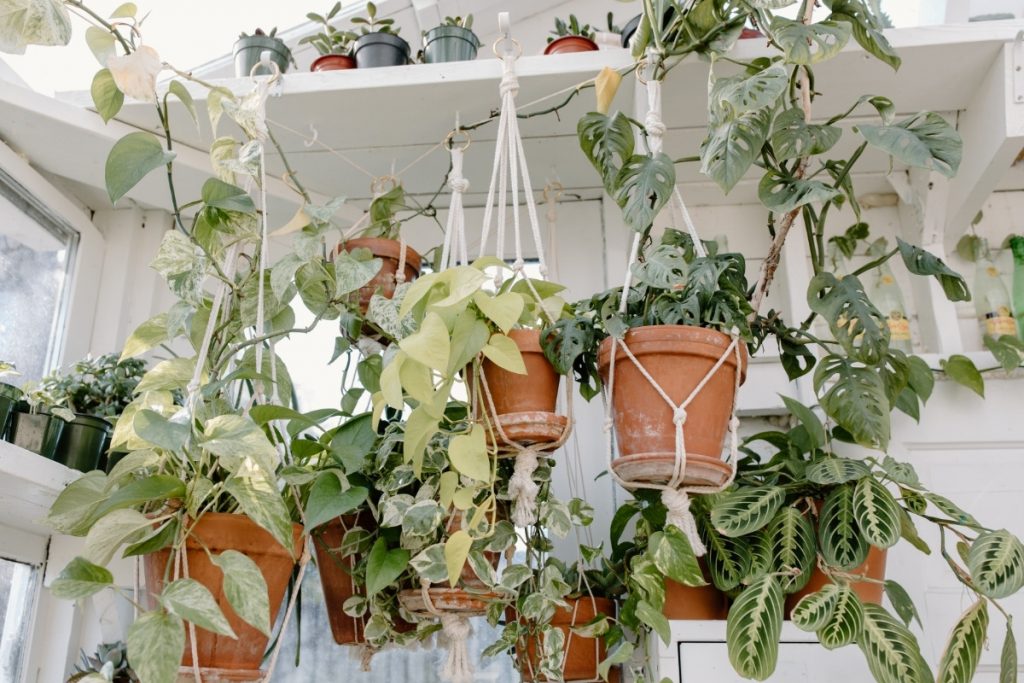
When you’re decorating your home with plants, it’s important to keep in mind the many available different growth patterns. You may be familiar with plants that grow straight upward, like trees, or upward with voluminous leaves, like peace lilies. – but there is more than one type of plant!
The first example is placing a plant in a pot that is hung in a window or from the ceiling. This can be great for spaces without many surfaces or with limited space, or simply for adding some depth and variety to your area. Plants that do well in hanging pots are those with trailing stems/leaves, such as a string of pearls, a string of hearts, or spider plants. If you let them grow long enough, these will grow to a beautiful length and will have plenty of space to do so without overtaking a whole countertop.
You can also grow climbing plants, like vines and Monstera varieties. The best way is by choosing one that naturally grows upward so it anchors itself in the surroundings; many shops online sell patterned metal frames for this purpose!
Toxic House Plants
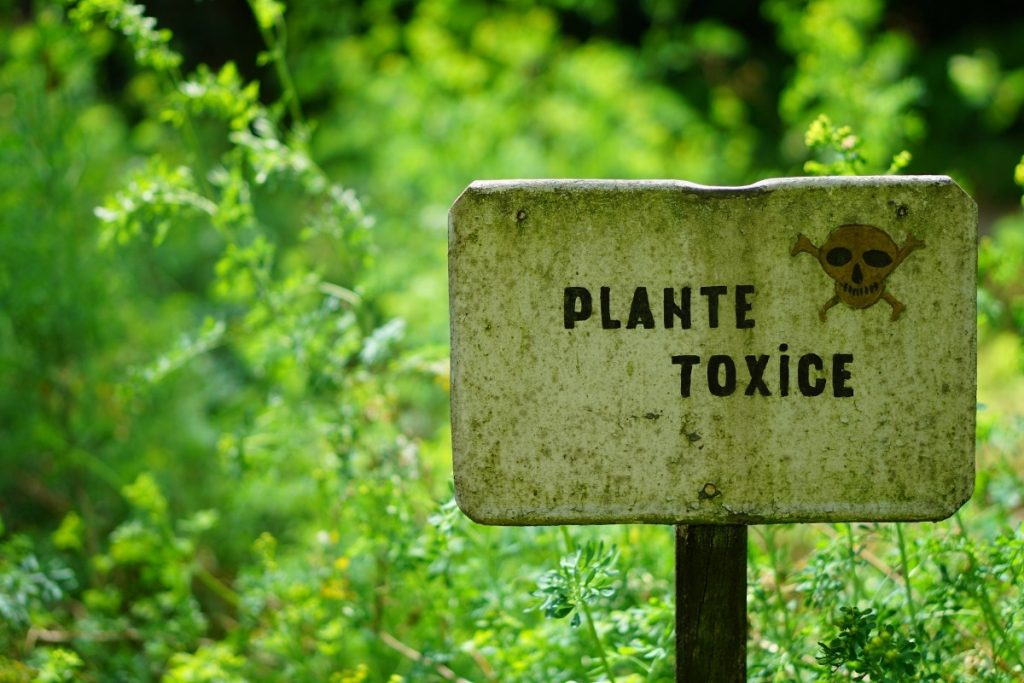
Indoor plants are the perfect addition to your home. They can be used as centerpieces on bare tables, as decorations in living rooms, or displayed outside of windows to make a statement about fresh air and natural beauty! But before you buy any plant at all check its toxicity level because some Common houseplants may contain substances harmful if ingested by animals (like cats), and children. So take caution while selecting which type will suit best who occupies space inside our homes.
Some common toxic houseplants:
- Azalea
- Croton
- Crown of Thorns
- Cyclamen
- Hydrangea
- Clivia
- Pointsettia
- Swiss-cheese plant
- Philodendron
- Pothos
These are just a few examples. If you have pets or children, be sure to double-check before purchasing any new houseplants to ensure that they are not toxic. However, if you are not worried about any accidental consumption, these plants can all be great choices for your home when given the right care and maintenance.
We all know that plants are the best friends anyone could ever hope for. The process of choosing one, though? It can be difficult! Luckily we’ve put together some tips on how to make your decision because there is no wrong answer when it comes down to selecting living artwork from around this green world to bring life back into any space at anytime day but still familiar feel free to explore options until finding what suits YOU personally perfectly!!!
Potting And Repotting Houseplants

The first time you pot a plant, it’s crucial for its future health. If done wrong and as such, there is little chance of success in growing well.
“Root cuts carry more risk than cutting leaves.”
You can’t skimp on potting soil when it comes to growing your favorite plants! The consistency of the mixture you use will have a huge impact on how well they thrive and what kind(s) grow best in them. Houseplants thrive in a mixture of potting soil that includes peat, perlite, and regular dirt.
The preferred soil for a given plant will vary depending on its species. For example, cacti and most succulents grow best in half-soil with coarse sand added to the mix while ferns prefer more organic material such as sphagnum moss or bark dust over clean earthy smelling loam which is better suited towards leafy greens like camellias if you want them healthy enough not just long-lived but vibrant too!
The potting soil that you use is an essential part of determining the success of your plants. You can purchase a pre-mixed commercial product or make it yourself with ingredients found at home, But whatever mix you use, make sure it’s moist, not dry or wet when you’re ready to use it. Tender roots settle better and will be less damaged in damp soil.
One important factor to remember when potting plants is to make sure that there is good drainage. This can be done by placing a coarse layer of material into the bottom of the pot before adding the soil. Broken pieces of clay pots or small rocks are fine for this purpose.
When potting a plant, you’ll need to make sure that you’re using the right size pot. If the plant is young and you know that it will develop rapidly, choose a pot that leaves space for it to grow. If you select one that is too small, you will need to report it before long. However, don’t choose one that is too large either. This can cause the soil to take too long to dry out, leading to root rot.
Furthermore, to avoid any unfortunate accidents when using the same pot for a second time around make sure it is clean before reuse!
If a plant’s roots start to outgrow its pot, it will need to be repotted into a larger one. You can tell when this is necessary because the plant will start to get taller and bushier than it was before. Repotting should be done every three or four months, depending on how fast the plant grows. Slower-growing plants should not be repotted more than once a year. Repotting should also usually be done in the spring or early summer, before the growing season.
In addition, as a general rule, most beginners should be using clay pots, rather than plastic pots, as plastic pots do not allow the soil to “breathe”.Clay pots are a great choice for houseplants because they allow the soil to “breathe.” This is important because it helps prevent the roots from becoming waterlogged.
Normally, when placed in a larger container, the roots of a plant should not be disturbed at all. Just add fresh soil to the base, sides, and top of the pot. However, if the root ball has been over-packed, poorly drained, or has built up too many soluble salts from hard water, you will need to do some heavier removal as you repot. Do this gently, after carefully watering the plant before repotting so that roots are damaged as little as possible. Spread the roots as you place them in the newly potted soil.
Beginners are often worried about destroying plants in repotting, but as long as you know what to look out for, it is an easy procedure that can be carried out without damaging a plant. Always water the day before you report so that the root system is evenly hydrated.
Potting Instructions
Before you begin, acquire your pot and soil.

You’ll want a pot that is big enough to support your plant’s growth, but not more than 1-2 inches (2-4 cm) bigger than the plant’s existing root system. A pot that is too big can cause root diseases due to excess soil moisture. A container too small, on the other hand, limits the growth of a plant and can cause it to become root-bound, meaning the roots mat up at the bottom and sides of the pot.
Make sure your pot has at least one drainage hole. Plants in containers without drainage holes remain damp longer, placing them in danger of root rot and fungus. If you have no drainage holes and no way to create any, you can cover the bottom of the pot with pebbles, so any excess water will sit away from the roots and be absorbed slowly.
Nowadays, pots are made from various materials – clay, ceramics, plastic, fiberglass, etc. Clay continues to be regarded as the best house plant container as it offers excellent aeration for plant roots.
Note – Sometimes, plants that you buy in a store come in a clay pot already. Clay pots are very porous and their walls will hold humidity and plant root nutrients, allowing your plant to absorb them slowly. If you don’t like the look of clay pots, try inserting them inside a decorative pot or container so that you still get the benefits without the aesthetic.
Soil
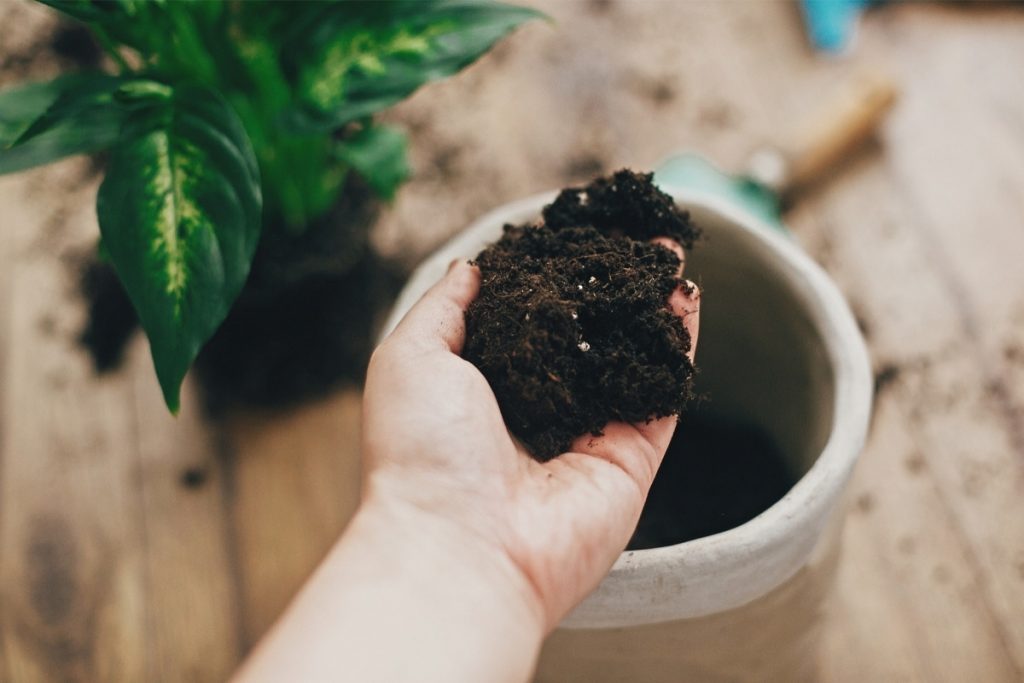
Potting soil is a mixture of rich organic materials such as peat, compost, vermiculite, and barks particularly designed for container-growing plants. You may also want to buy organic potting soil, which these days is not too costly. fertilizers
You can also mix your potting soil. This gives you the control necessary to create a customized and ideal environment for each plant. I will cover this more in the chapter on soils.
Terrariums
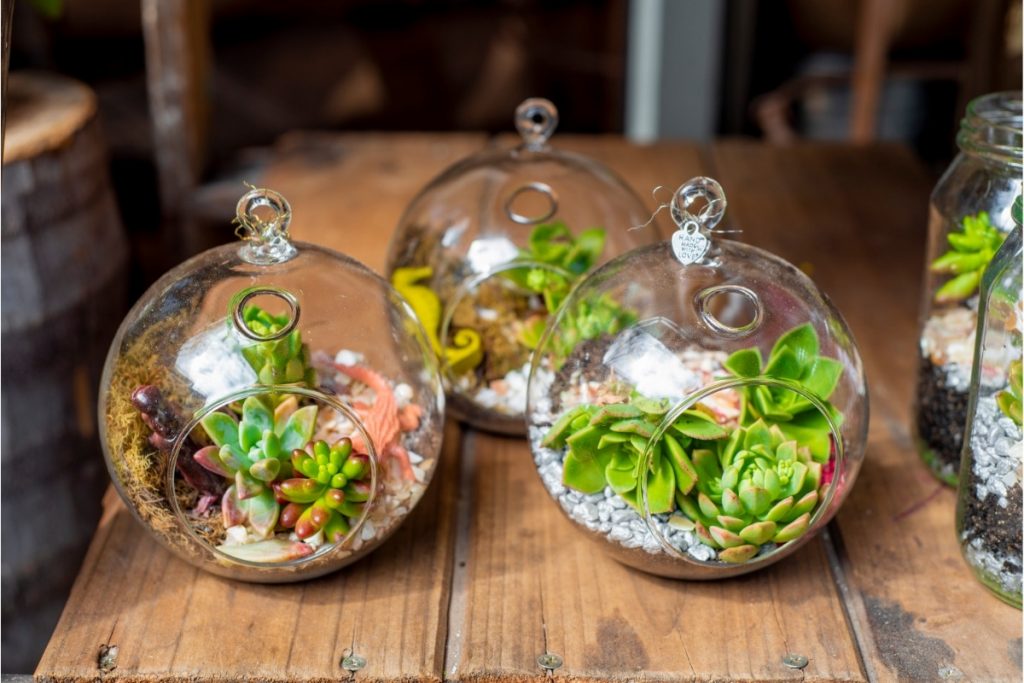
A terrarium can be an easy way to fill your house with greenery while making much of the day-to-day care significantly easier. Terrariums are containers, usually made of glass, which are fully or partially closed to trap moisture, retain warmth and humidity, and allow for appropriate gas exchanges. They also can be decorated in fun and interesting ways, like a fishbowl or a diorama, with multiple different types of plants.
When choosing plants for a terrarium, choose varieties that are happiest in high humidity, as the glass will trap moisture even if it is partially open. However, this can be ideal if you live in a dry area or your house lacks humidity; it can give you the chance to host some interesting tropical plants without needing to be constantly manually maintaining a humid environment for them!
To build a terrarium, you will need a glass container such as a mason jar or a fishbowl. First, lay down a layer of sheet moss to soak up any excess water that collects at the bottom. Then, place a layer of gravel or small rocks to separate your plants from that excess moisture. You may also want to add a small layer of activated charcoal, as this can improve drainage.
Over the rocks, start layering in your potting soil using a small tool, such as a spoon or a miniature trowel. Your soil should be fresh, sterile, and slightly moist (but not damp). Start adding your plants in, arranging them as desired. You will want to choose plants that are small enough not to crowd each other or get pressed up against the walls, as well as plants that have similar soil and humidity preferences. Some good choices for terrariums include ferns, mosses, pothos, and fittonias, but there are hundreds of options at your disposal. Cacti and succulents are also popular in dry environments for terrariums.
From here, you can get creative. You can put in figurines, build a miniature “fairy garden”, make a river out of rocks… the options are endless! You can find inspiration for terrarium decoration online (Pinterest and Instagram are good places to look).
Once you have everything in its place, spritz your terrarium with water. Be careful not to add too much – remember, this water will not evaporate or drain out like in a regular potted plant. If you are building a closed terrarium, place the lid on it. Now you can sit back and watch it flourish!
If any condensation accumulates, open the lid and air it out for a bit. Keep an eye out for yellowing or fallen leaves. The terrarium may take care of itself for the most part, but you’ll still need to check on it occasionally to make sure it is still an adequate environment.
Now, a fun fact: closed terrariums are particularly interesting for their gas exchange properties. You probably already know that plants consume carbon dioxide as part of their process of photosynthesis, but did you know that they also “breathe” oxygen at night? Because of this, plants can continue to recycle the air even when they are trapped in a closed container. They simply reuse the same air over and over, taking in carbon dioxide during the day and releasing oxygen which they then breathe during the night and convert back to carbon dioxide!
Choosing The Right Soil
The best way to ensure your houseplants are healthy and happy is by choosing the right soil for them. Every plant needs a special type of dirt that matches its native habitat, so this will help with drainage or moisture retention depending on what you need from it! In addition, there are also things like airflow (which helps prevent roots rot) nutrients–just all-around better quality living in every sense if they’re planted correctly.
For those who are just getting started with gardening, it can be daunting to find the right soil mix. If you’re looking for something that’s specifically made for cacti and succulents then make sure your nursery or home improvement store carries bags of potting soils labeled as such!
However, house plant enthusiasts will often mix their soil to ensure that the plants have exactly what they need. This is easier than it sounds and a popular choice among those who care deeply about these organisms.
Mixing Your Own Soil

There are three basic ingredients to a potting mix: compost, aeration agent, and peat. These can be combined in different proportions for the perfect mixture depending on what kind of plant you want it to grow into! Other additives may also need to be added such as nutrients or minerals if needed – but make sure not too much is applied at once because this might causeNL blooming sooner than expected
Some common ingredients
Sphagnum peat moss: This is the bulk of most potting soils. It is great for moisture retention and is very stable, so it is a great ingredient to start your mixture with. However, it is very acidic and often does not provide enough drainage on its own, so it must be tempered with other ingredients.
Perlite: a naturally occurring volcanic rock, perlite looks a little like tiny balls of Styrofoam and will provide better drainage and aeration. It also retains water without fostering an overly wet environment for rot and fungi to build up.
Vermiculite: similar to perlite, vermiculite is great for adding drainage and aeration to your soil. However, it is a mineral, so it also adds nutrition to your soil (specifically calcium and magnesium).
Lime: since sphagnum peat moss is so acidic, lime is an essential ingredient for lowering the pH of the soil so as not to harm your plant. This is often sold as a limestone powder that can be added in small amounts to a soil mixture.
Compost: Compost is a rich source of bio-active nutrients and beneficial bacteria that will foster your plant’s growth. If you don’t happen to have your own compost pile ready to go in your backyard, this can usually be purchased from your local garden supply store or nursery.
Fertilizer: can be used in place of or in conjunction with compost.
Coarse sand: sandy soils are preferred by plants native to dry environments, such as succulents and cacti. Its primary function in a soil mixture is to improve drainage.
There are hundreds of soil recipes online, but a very basic mixture that is good for house plants is as follows:
- 2 parts sphagnum peat moss
- 1-2 parts perlite
- 2 parts coarse sand
- A pinch or two of lime
- A pinch of fertilizer and/or compost
With this base mixture, you can either look up ways to adjust it according to your plant’s needs, or you can simply play around with it and experiment to figure out what works best.
Semi-hydro Potting and LECA Beads
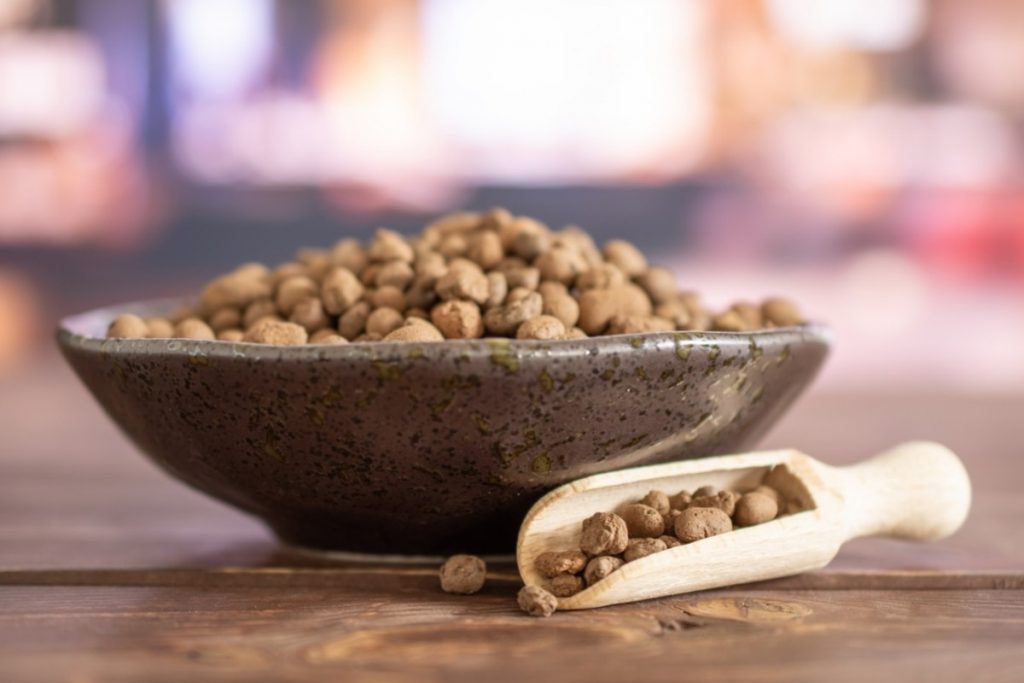
There is an increasingly popular method of potting available that does not involve any soil at all and can be a great choice for your house plants: “semi-hydro”. This involves keeping a plant’s roots submerged in water but surrounded by small clay pebbles (called LECA, short for “lightweight expanded clay aggregate”). This gives the roots something to grab onto and grow around, keeps the plant consistently hydrated, and avoids some of the unwanted fungi or bacteria growth that can occur in a soil mixture.
To use LECA, you’ll need two pots: one that is sealed with no drainage hole, and a slightly smaller one that has many holes along the bottom and sides. Orchid pots work very well and are fairly cheap to purchase on Amazon.
Fill the plastic orchid pot (or other well-draining pot) partway with LECA beads. Place your plant in the pot, making sure there is no soil or other debris still sticking to the root system. Carefully, using a trowel or other small tool, begin placing the clay beads around your plant’s roots, making sure not to damage the roots. Fill the pot up until your plant is supported enough to stand upright on its own.
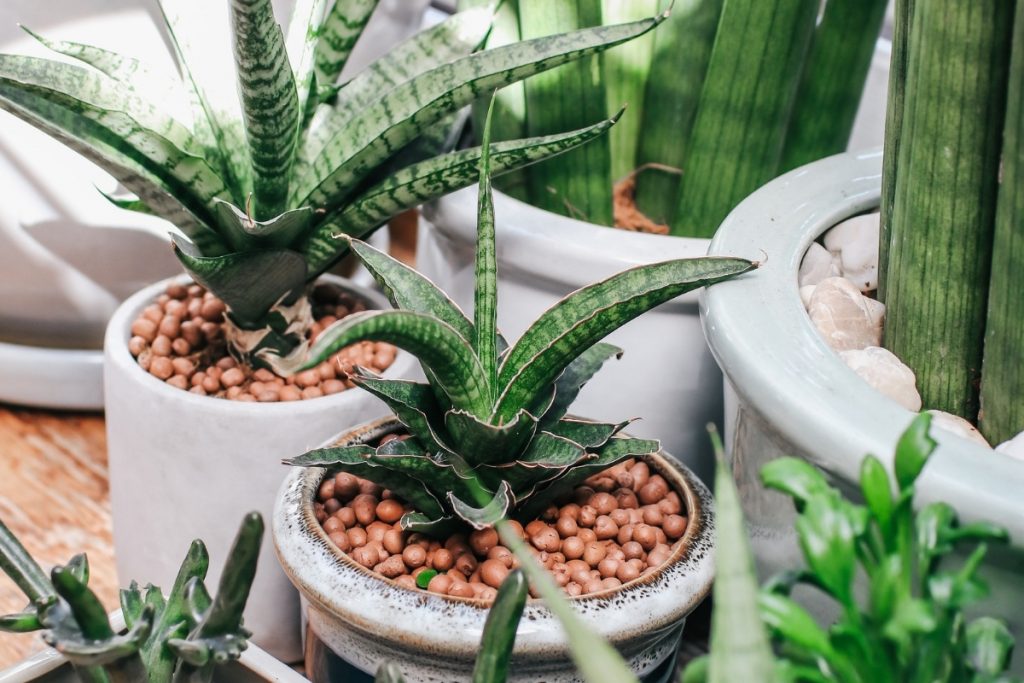
Then, place the LECA-filled pot with your plant inside into the slightly larger, non-draining pot. This will act as a container for the water. Fill the container up with water, submerging the root system entirely but avoiding submerging any of the stems and leaves.
If you want to skip the orchid pot, carefully place the beads around the roots, layering as you approach the top of the glass container. This method is also very easy and successful.
From then on, you will simply have to ensure that the water is clean, regularly replenished, and at the correct level. Keep an eye on it to ensure that no mold is growing, and you should have a very happy plant in no time!
Pests
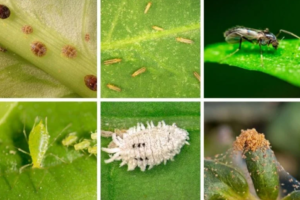
Pests are one of the most infuriating problems that a houseplant owner is likely to face. Many of them are difficult to rid your plant of, and one infested plant can spread pests to all your other plants at the drop of a hat. However, the more you can learn about what to look out for and how to deal with different types of pests, the better equipped you will be to keep your plants healthy and avoid this problem.
The best way to avoid a pest problem is to never introduce them into your home environment in the first place. This is easier said than done, but the most important step is to always quarantine any new plants you are introducing into your collection.
The most common types of pests infesting houseplants are:
Spider mites
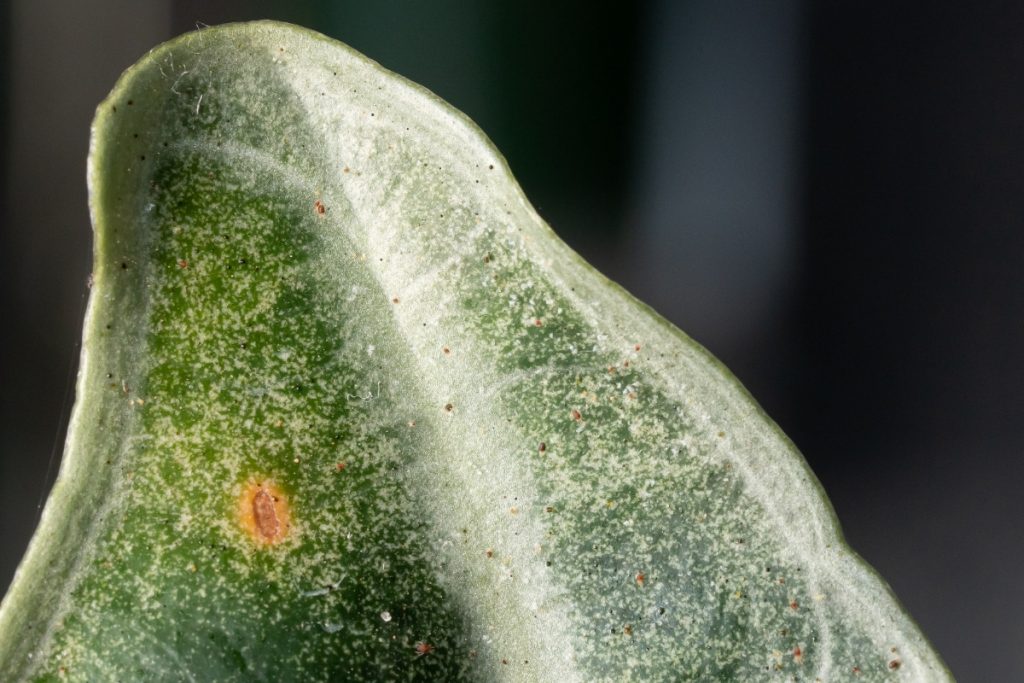
These mites are very small, so they can be hard to spot on their own, but they leave behind very easily identifiable webbing. It looks similar to a spiderweb or cobweb and usually shows up on the undersides and base of leaves and stems. An untreated infestation will cause leaves to slowly turn yellow and die, eventually killing the plant altogether.
The best treatment for spider mites is a solution of neem oil, dish soap, and water, spritzed on the plant regularly until the infestation is eradicated. Neem oil is a natural and effective pesticide that can be purchased online or at any garden supply store.
Whitefly
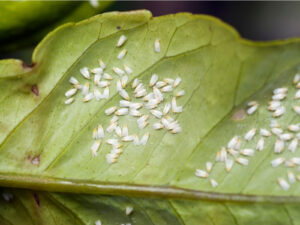
These pests are very small flies with white wings, hence the name “whitefly”. They range in size and can be hard to spot due to their small size, but an infestation can be spotted by looking closely at the underside of your plant’s leaves. If there is a significant infestation, you will see them fly up and away from the plant when it is shaken or disturbed. But if you don’t see a swarm of flies or spot any adult flies under the leaves, don’t assume the plant isn’t infested – there may still be microscopic eggs and larvae clinging to the leaves.
To treat a whitefly infestation, you will need to take a double-sided approach. Introduce sticky fly traps to catch the adult flies, and simultaneously, spray the leaves regularly with a neem oil mixture. This will kill any larvae and eggs.
Thrips
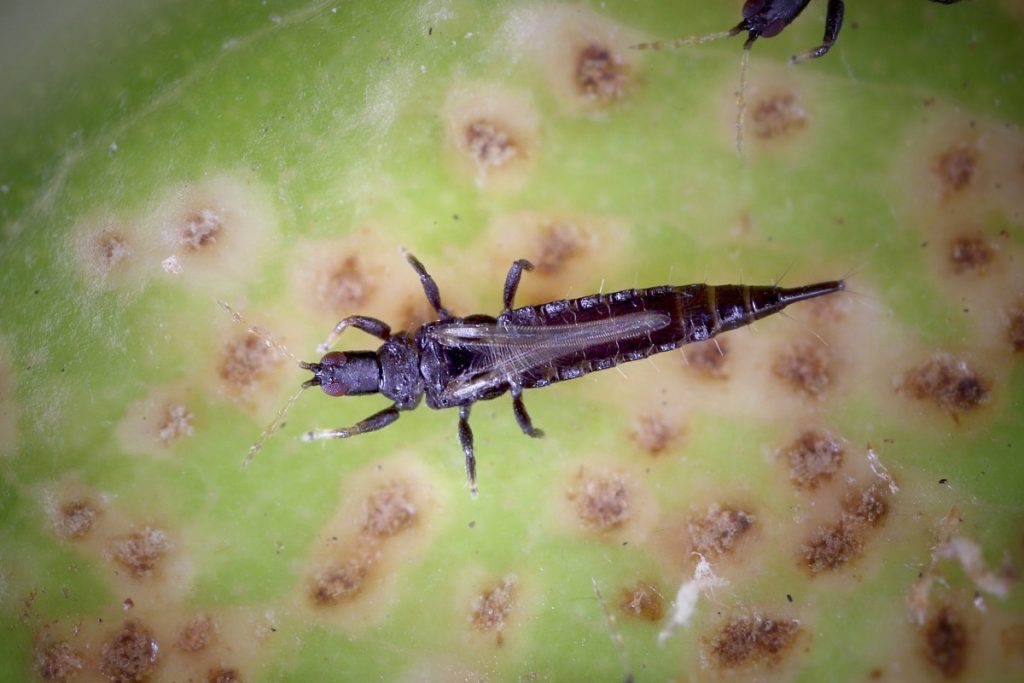
Possibly the most dreaded pest among houseplant enthusiasts. Thrips are small, thin black or brown bugs with the pointed tail end. They can fly between plants, which is part of the reason they are regarded as such a virulent pests. Untreated, a thrip infestation will cause yellowed or discolored leaves, stunted growth, and the infestation will spread.
Thrips are notoriously hardy and difficult to get rid of, but some people find success by carefully washing the plant’s leaves individually with warm water and dish soap, and following up with a regular treatment of neem oil. Others, however, choose to take a more extreme route and introduce natural predators (usual ladybugs) into the home to control the pest problem naturally.
Aphids
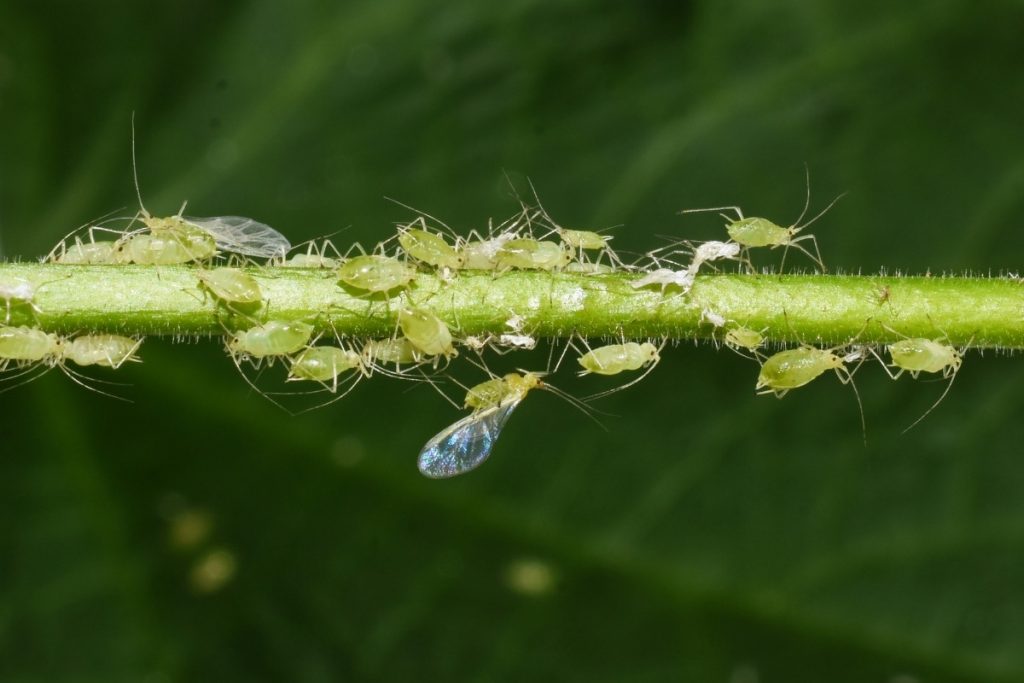
You likely know aphids as small green bugs, but they can be a variety of colors ranging from black to brown to even yellow or blue. They can usually be spotted in clusters on the leaves and stems of a plant. They may also accompany a black fungus. To treat aphids, you can wash the leaves with dish soap, then continue spraying the plant regularly with a soap and water combination. Alternately, they can be killed with rubbing alcohol, neem oil, or ladybugs.
Fungus gnats
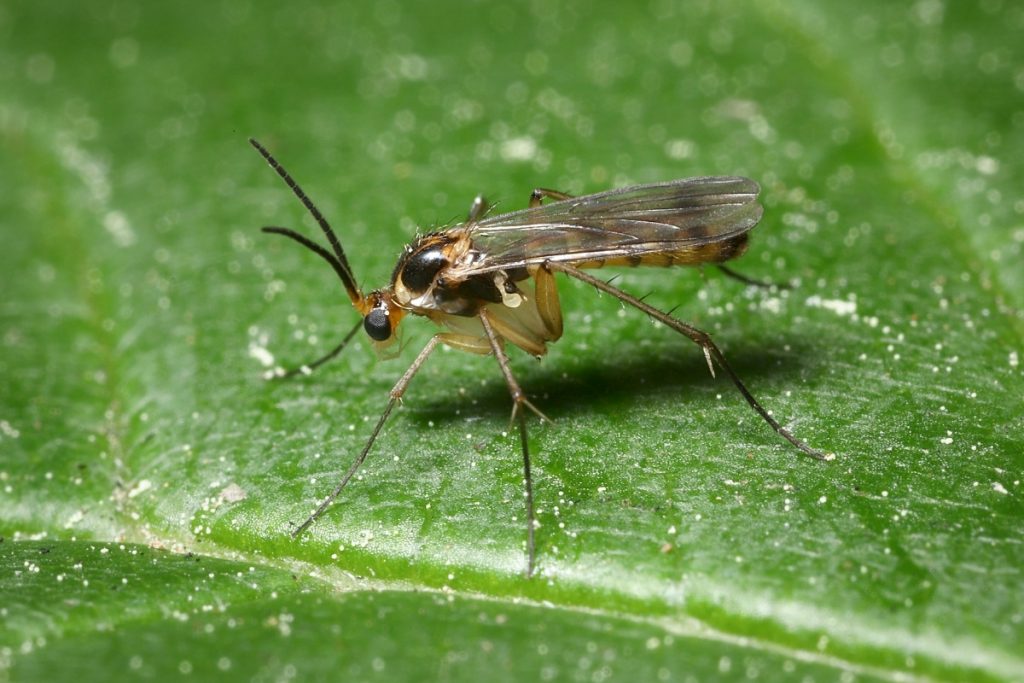
Unlike most other houseplant pests, these little bugs don’t feed on the plant itself. Instead, they feed on a certain fungus that grows in the soil. A fungus gnat infestation is not usually a problem because of the pests themselves. Instead, it is indicative of fungus growth that can be harmful to your plant over time. A heavy infestation can be damaging to roots, but these cases are rare. You can identify these gnats easily as they will be flying and swarming around your plant, particularly near the soil.
The best way to deal with fungus gnats is to deal with the root problem: the fungus. Re-pot your plant, cut out any rotting or molding roots, and start fresh, being careful not to over-water your plant in the future. Additionally, you can use a natural bacterial treatment called BTI or H-14, which is specific to fungus gnat elimination.
Mealybug
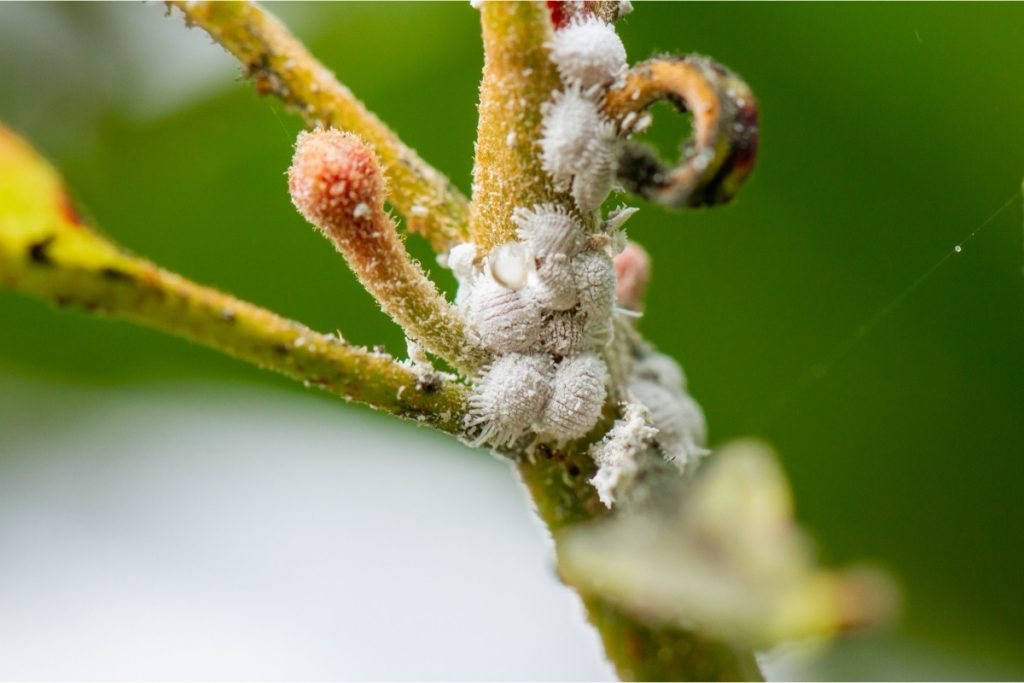
These tiny white pests look like small bits of white cotton or dusty white specks attached to your plant’s stems or leaf joints. Like aphids and spider mites, mealybugs will cause leaves to yellow and eventually will kill the plant if left untreated.
When you catch a mealybug infestation, you can use a cotton ball soaked in rubbing alcohol to remove the bugs individually, then repeat this daily until all the bugs are gone.
Scale

While this sounds more like a disease than a pest, “scale” is a type of insect which are named for how they look when grouped on a plant’s stem. They are small, usually brown, and are often mistaken for just being bumps on an otherwise healthy stem.
Just like mealybugs, these can be killed with rubbing alcohol. However, if your plant has a scale infestation, then some of the insects will be living in the soil and you will have to report your plant with fresh soil to prevent the infestation from recurring. A sticky secretion is an indication of scale on your plants.
Various mites

Unfortunately, these are impossible to see with the naked eye because not only are they microscopic, but they also usually live inside the plant rather than on its surface. However, a mite infestation can be identified by its effects, usually causing curled leaves, stunted growth, and other problems. Plants infected by mites usually need to be tossed out altogether to avoid spreading the infestation to other plants.
There are many other types of pests out there, so if you suspect that your plant has an infestation of any kind, consult your local specialist, online group, or plant book. Different plants are susceptible to different types of infestations, so it can be helpful to look up what pests your plant is most susceptible to so you can keep an eye out for any signs and symptoms.
Fertilizer For Houseplants
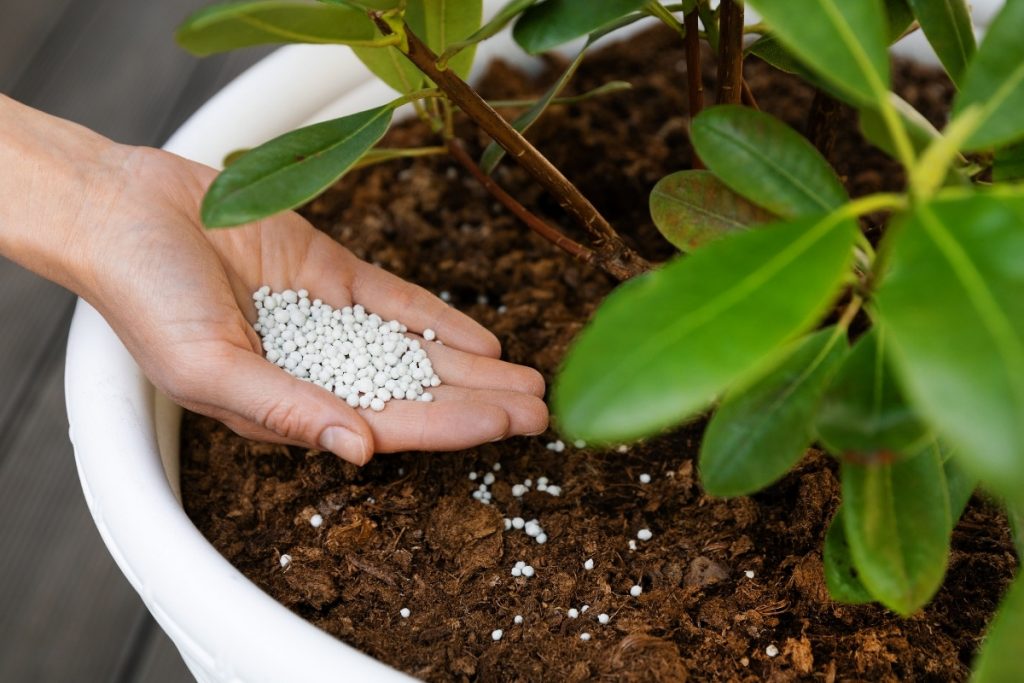
Our house plants make our homes beautiful and colorful all year round. Many even help eliminate our indoor pollution contaminants. So, when we keep them in our homes, we need to make sure we treat them with the same kind of love they give us. One way we can keep our plants happy is by fertilizing them and providing them with all the nutrients they require to thrive.
What do the fertilizer bag numbers mean?
Most fertilizers include three plant minerals: nitrogen (N), phosphorus (P), and potassium (K). The proportions of each account for the listed percentages of these three nutrients. A 20-10-15 fertilizer contains 20% nitrogen, 10% phosphorus and 15% potassium. These are not the only elements a plant requires, but they will often give you a good idea of what you are giving your plant.
How much does my plant need of each mineral?
This depends, of course, on what kind of plant you fertilize. It’s really important not to offer too much or too little food to your plant – and over-fertilization is a very common problem. Fertilizer needs are very dependent on each plant. Both the label that comes with your plant, if there is one, and the label on the fertilizer bag should be read carefully. If you are still unsure, consult a specialist in your local nursery.
What is every mineral doing?
Scientists are continuously investigating this subject. For gardening purposes, it can be said that phosphorus is needed in greater amounts for flowers while leafy plants prefer high nitrogen. Potassium is especially needed for plants that bear fruit because it helps carry other nutrients through the tissues of the plant.
What are the signs of malnutrition?
Inadequate fertilization will make the plant leaves pale or underdeveloped. A fertilizer solution can be used to remedy this so that the plant can consume nutrients faster. When plants are over-fertilized, the leaves may turn brown at the tips or begin to yellow. In this scenario, you can water the plant thoroughly to rinse off the excess minerals.
How do I fertilize my plants, and how often?
My personal preference is to use “liquid” fertilizers because over-fertilization is more difficult. Dry fertilizer is dissolved in water with the box instructions. The plants are then fed by pouring the solution into the pot until the holes in the bottom flow out. I do this every two months – and a little more often in the blooming season.
If you use care in feeding your house plants, they will not only survive, they will thrive and flourish. Don’t hesitate to ask for advice if you have problems. You can ask for help at your local nursery, plant store, or even online.
Propagating Your Houseplants
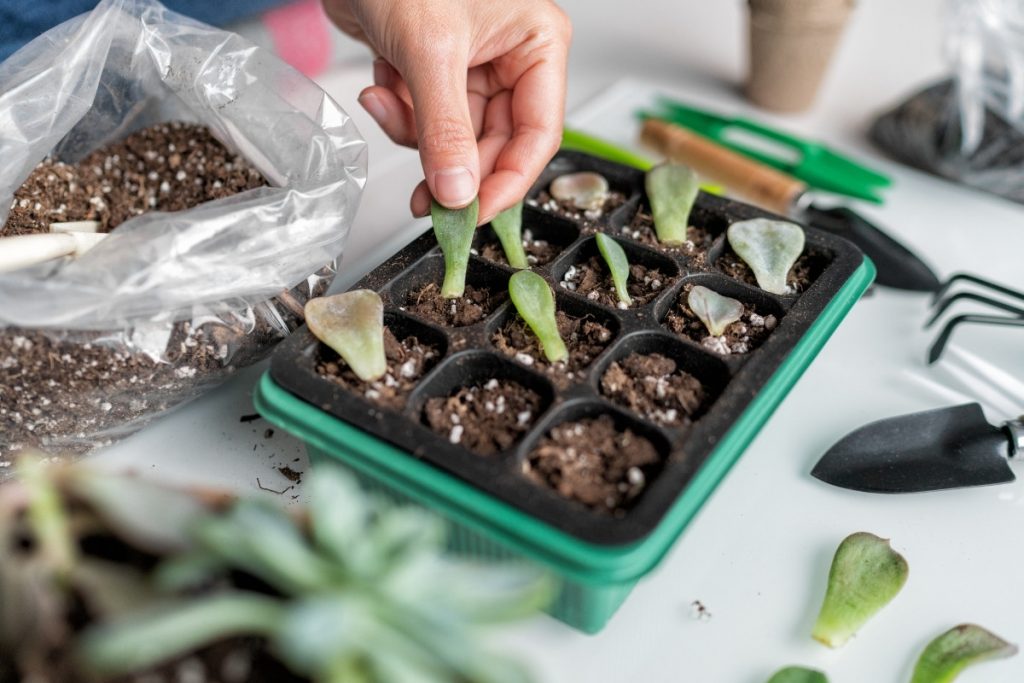
Part of the fun of growing house plants is to propagate them. Propagation is the process of using a small cutting of a full-grown plant to create a new plant, which is a “clone” of the parent. This process is not foolproof; perhaps a friend or neighbor promised you a young plant or piece of their plant, but you can’t manage to root it because the cutting was not done correctly or is too old. Fortunately, most house plants are fairly simple to propagate as long as you follow a few guidelines.
Tools For Propagation
The tools you will need may vary depending on the style of propagation you choose for your plant, but in general, you will need:
- Clippers, scissors, or a sharp knife
- Plastic or terracotta pots (for re-potting)
- Plastic or glass cups (for rooting)
- Rooting hormone
- Artificial light
- Appropriate soil mix
- The plant to be propagated!
Clippers: When you are making any cuts on a plant, whether it be to the stem, leaves, or roots, you must use a blade that is sharp and clean. A blade that is not sharp enough can cause unnecessary damage to the plant, creating a wound that will take longer to heal and be more susceptible to pathogens. Clean all blades with alcohol, hydrogen peroxide, or some other sterilizing agent. If you are working on multiple plants, make sure you clean your clippers in between each plant as well, even if you believe all your plants are healthy.
Pots: Make sure you acquire all the necessary potting materials before the time comes to transplant your newly propagated plants into the soil. Know the appropriate size to choose (most propagated plants require a relatively small container for their first potting). If you are reusing old pots, wash them thoroughly with soap and warm water. If you are using terracotta or any other unfinished/unsealed clay pot, soak it in water before adding soil, as clay absorbs moisture. Always make sure there is at least one drainage hole.
Cups for Rooting: When it comes to rooting a plant in water, the container you choose is not important. Don’t worry about the aesthetic appeal. There are plenty of cheap or free options you can use, such as red party cups, old yogurt containers, mason jars, etc. Just make sure they’re completely clean before using them.
Rooting hormone: This is usually available as a fine white powder and is sold at most garden supply stores and nurseries. It is just the hormone that plants naturally create to grow, so dipping a cut root in it promotes healthier and faster growth.
Artificial light: If you are propagating in the winter, live in a home with inadequate natural light, or are propagating a plant that requires more light than the average house plant, you may want to invest in some artificial LED lights to help your young plant in its growth journey. This can be a good choice simply because it gives you greater control over the amount of light your plant is exposed to. For example, if the only places you could place your plant get full, unfiltered sun, you may want to opt for artificial lighting instead to make sure it does not burn. Artificial lights are sold online and in some home-and-garden stores, and they are available as lightbulbs or as adhesive strips depending on your needs.
Appropriate soil mix: Be sure you know what potting mix your propagation needs before you attempt to transplant it. Different plants have different requirements; a succulent will not do well in a regular potting mix, and a fern will not do well in coarse sandy soils. If you are unsure of what to buy, ask your local nursery assistant or an online group.
Types of Propagation Not every plant in the world can be successfully propagated, but fortunately, almost any common house plant can be. However, different plants must be propagated in different ways due to differences in their biology and structure. It’s important to know which type of situation you are dealing with before attempting to propagate.
Conclusion
I hope you have gained some useful knowledge from this article about how to incorporate plants into your life. Plants bring something beautiful and alive into a house and make it a home, and they can improve not only your physical well-being but also your mental well-being. For many people, keeping houseplants is a form of therapy and grounding. If you started this book without a single plant in your home, I hope you’ve gone out and bought one for your space and are enjoying the beginning of your foray into this new world. If you started this with plants already in your life, then I hope you picked up some tips on how to make your plants as happy and as healthy as possible. Thank you for reading!

